 | E-mail to Birds Korea |
 | KWBS |
in the Region
 | The Oriental Bird Club |
 | BirdLife International (Asia) |
May
Like April, a great birding month. Temperatures begin to climb with day maxima often reaching or exceeding 25°C by the end of the month, though feeling cooler on offshore islands due to low sea temperatures and wind. Fog can temporarily limit birding, while inclement weather can result in spectacular falls of migrants.
Northward migration continues, and diversity can be exceptional. Mongolian Plovers, Red-necked Stints, Broad-billed and Spoon-billed Sandpipers peak at the Geum Estuary, while Chestnut Buntings outnumber Yellow-throated and Black-faced Buntings. Mugimakis, Dark-sided and Grey-streaked Flycatchers also start to arrive, often peaking in the second and third weeks of the month. Brown and Thick-billed Shrikes, Siberian Rubythroats and Broad-billed Rollers add colour and quality to the birding mix. By late May locustella warblers (Lanceolated, Pallas’s, Middendorff’s, Styan’s and Gray’s Grasshopper) arrive on western islands. At the end of the month, Ruddy Kingfisher, Black Paradise Flycatcher and small numbers of Fairy Pitta are also in territory and vocal, though still elusive and easily disturbed. Breeding Chinese Egrets and Black-faced Spoonbills are widespread at the best sites (especially in the northwest) and Saunders’s Gull have also nested in Gyeonggi Bay annually or near-annually since at least 1999.
In recent years May has produced several records of national rarities like Cinnamon Bittern, Band-bellied Crake, Black-winged Cuckoo-shrike and Black-headed Bunting. Most years, there are also one or more national firsts. In 2013, these included a Ryukyu Minivet on Gageo Island and a Slaty-blue Flycatcher on Baekryeong Island.
Songdo, May 31
Despite the bustle of activity just two weeks ago, it seems that the shorebird migration at Gojan mudflats is over. Saturday evening revealed a grand total of 27 individual shorebirds on the rising tide: 3 Eastern Curlews, 23 Grey Plovers (all in dull, non-breeding plumage) and 1 Nordmann's Greenshank (probably the same individual as two weeks ago). None were present on Sunday. Singles of Mallard and Eurasian Teal were the only waterfowl apart from the 200 or so Eastern Spot-billed Ducks. The regular patrolling Saunders's Gulls included an apparent juvenile, in addition to several juvenile Black-tailed Gulls. A quick visit to Incheon Old Golf Course on Sunday also turned up no migrants, just regular displaying Dollarbirds, singing Grey-backed Thrushes, Black-naped Oriole and Common Cuckoo.
Namhansan, May 31
Birds seen and heard included e.g. three Northern Hawk-Cuckoo, a Siberian Blue Robin, an Indian Cuckoo, a Yellow-rumped Flycatcher, one Common Cuckoo, several Eastern Crowned Warbler, an Oriental Cuckoo, a Grey Wagtail, and several Grey-backed Thrush, among other more common species.
Photography was difficult with the leafy shady forest, so the only thing to get snapped by my lens was one of the delightful Orange Hairstreak butterflies.
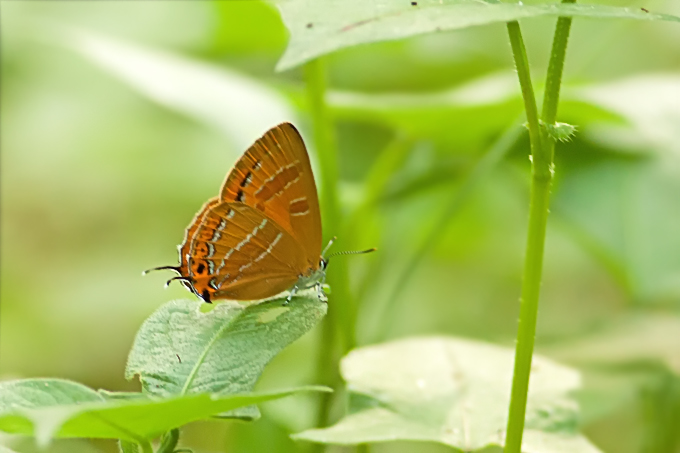
Socheong Island, May 28 - 29
An intriguing wind forecast sent me out to Socheong; the same and then shifting winds brought strengthening worries over fog, and sent me scurrying back to the mainland. Still, the visit was enjoyable, even if birds were somewhat thin on the ground and air. Highlights: several unseen singing Northern Hawk Cuckoos — beloved late-spring Socheong! Evidence of bittern migration: 4 Yellow Bitterns and 1 Von Schrenk’s Bittern seen in different spots. A few Lanceolated Warblers, a single singing Eastern Crowned Warbler, and a late but probable (heard briefly) Pallas’ Leaf Warbler. Several Korean Bush Warblers — one singing boldly from the top of a telephone pole. Low numbers of singing Indian, Little and Common Cuckoos. A White-shouldered Starling. 4 Black Drongos. 3 Thick-billed Warblers. Small numbers of Arctic, Dusky and Black-browed Reed Warblers and a single unseen Oriental Reed Warbler. Unseen Oriental Greenfinch. Black-naped Orioles — some seen and most heard. 4 Tiger Shrikes and 3 Brown Shrikes. A Light-vented Bulbul. A few Chinese Pond Herons, several Cattle and Intermediate Egrets. 1 Yellow-throated Bunting. A few Grey-streaked and Asian Brown Flycatchers. A single and brief thrush call—sounded like Chinese Blackbird. A single White Wagtail. Several Blue Rock Thrushes. Occasional Oriental Dollarbirds and Chinese Sparrowhawks. A pair of Peregrine Falcons. A Eurasian Hobby and several Barn Swallows. A single Little Grebe, actively diving.

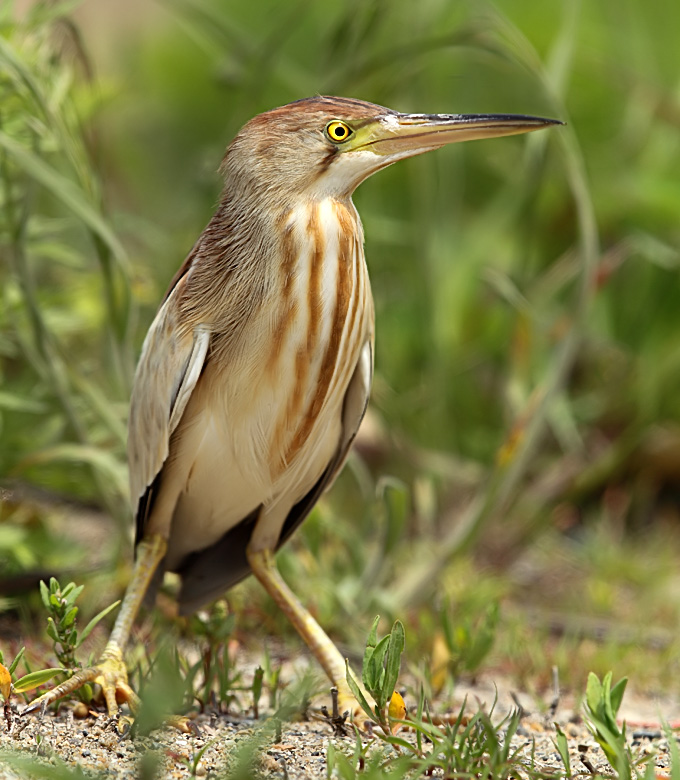
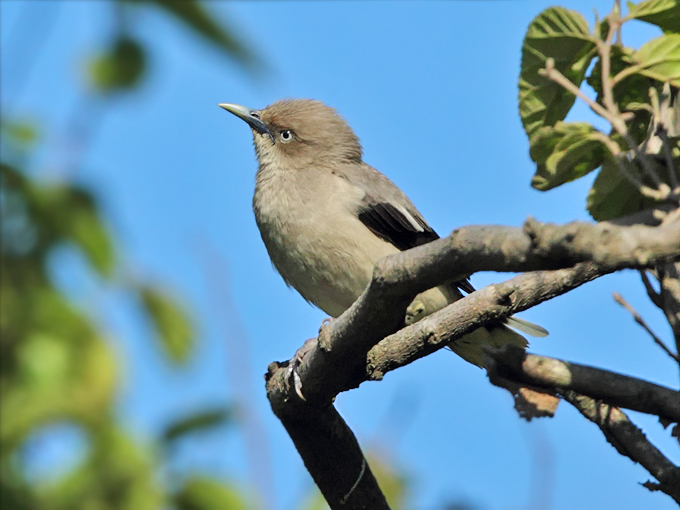
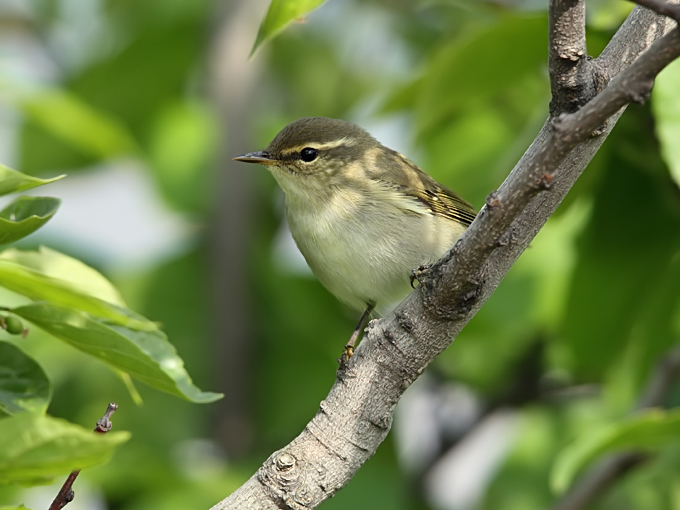
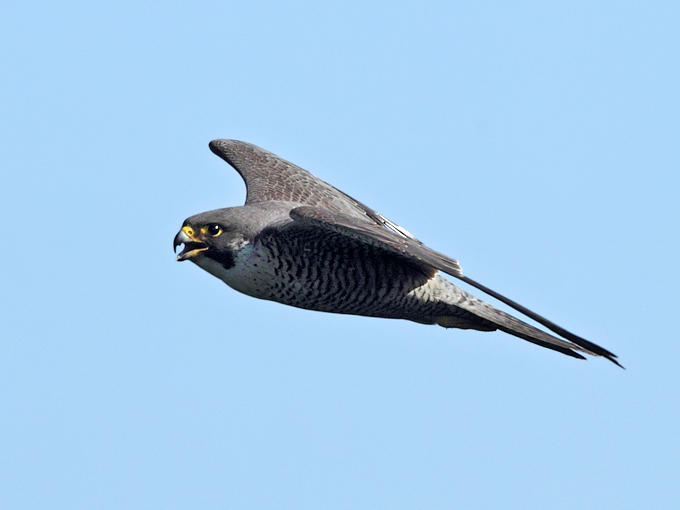
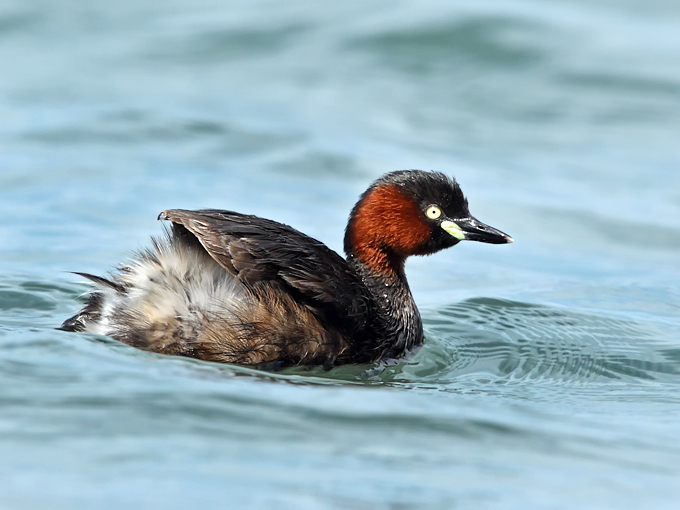
Baekryeong Island, May 28 - 29
Largely blue skies and warm temperatures (reaching a high of 22°C on the 29th), with the wind swinging from the west on the 28th to the southwest then south on the 29th. Unsurprisingly, there was a large clear-out of migrants.
Major species of note included a well-seen Manchurian Reed Warbler in Yeonhwa Village (at one time flitting through the same bush used by last year’s Slaty-blue Flycatcher - sadly too close to digiscope) and a male Asian Koel heard in the evening very briefly in Jincheon, both on the 28th; and two Hair-crested Drongo in the southwest in the morning on the 29th (one with beautifully up-curled tail feathers; the other, in the image, in “song” but showing much more tail wear).
Other highlights included two Ruddy-breasted Crake, a single Black Drongo, a female Russet Sparrow, a Yellow-breasted Bunting and 12+ Red Crossbill on the 28th; and another Fairy Pitta and Baikal Bush Warbler (both heard only), at least five Black Drongo (including two watched coming in high from the south at dawn); a late Brambling, five Black-faced Spoonbill (including one colour-banded bird), six Chinese Egret and large numbers of recently-hatched Black-tailed Gull seeking shade under adults on the 29th.
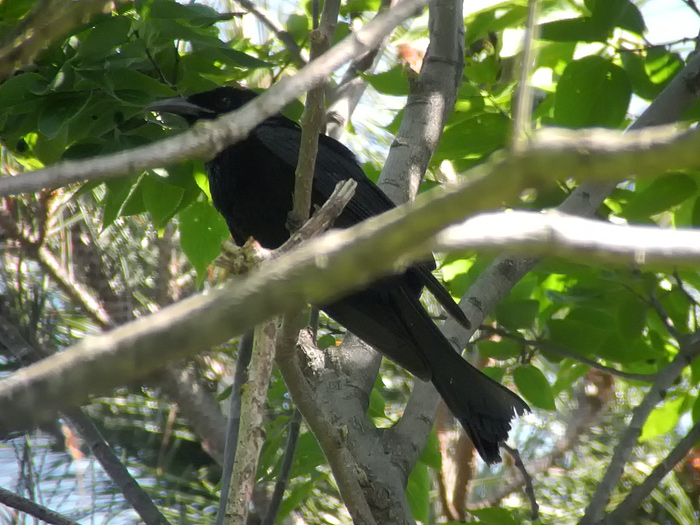
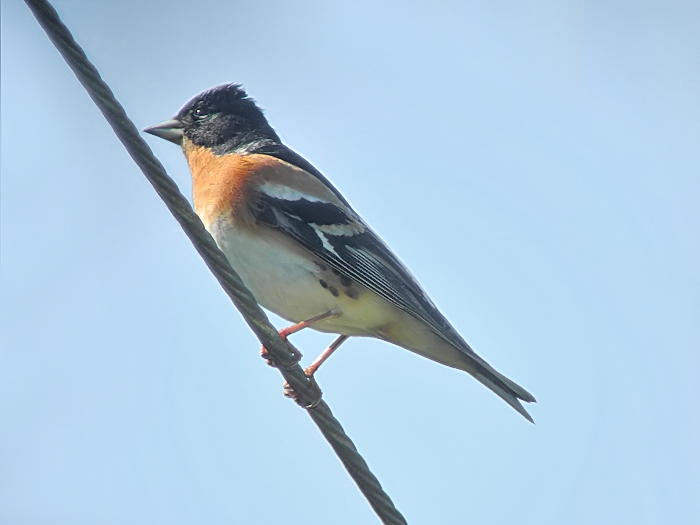
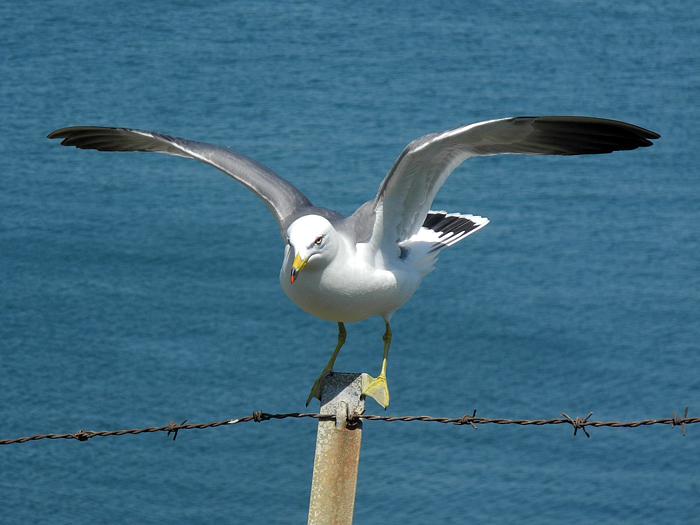
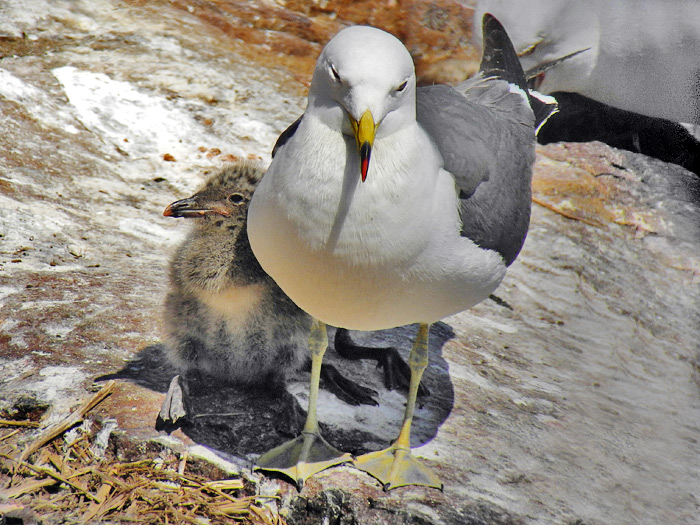
Baekryeong Island, May 27
Although 88 species were logged during a long day in the field (5am-8pm), it felt very much like the end of spring – with small numbers of late-spring migrants and warming temperatures during the day contributing to periods without much bird activity.
Most numerous landbird species during the day included Light-vented Bulbul (at least 50 and probably closer to 100, with one group of young fledglings also seen), Black-naped Oriole (40+), Black-browed Reed Warbler (40), Oriental Reed Warbler (35), Korean Bush Warbler (20+) and Arctic Warbler (20+). Other vocal late-spring migrants recorded in the west of the island included Tiger (10) and Brown Shrikes (20), Common (10), Indian (4), Lesser (3) and Oriental (1) Cuckoos and small numbers of locustella warblers, with about eight Lanceolated and four Pallas’s Grasshopper Warbler singing off and on in one small area.
Other land birds of most note during the day (almost all in the same area) included a Hair-crested Drongo, three certain Black Drongo and one odd-plumaged and extremely worn immature bird that was either a Black or rather less likely a black Ashy (therefore of a subspecies previously unrecorded in Korea); three or four Gray’s Grasshopper Warbler (some variation in songs heard suggested the likelihood – sadly unconfirmed! - of one Sakhalin Grasshopper); three singing Baikal Bush Warbler (including one seen); a decent count of 14 Thick-billed Warbler; and what appears to the start of a post-breeding gathering of starlings made up of White-cheekeds (but with two active nests also seen) with one Red-billed Starling too.
Waterbirds were less well-represented, with best for the day being a female Von Schrenck’s Bittern, three Chinese Egret and a briefly heard booming Eurasian Bittern at the main Hwadong Wetland. Although still quite birdy, water levels in the wetland are much lower than last year, and construction has likely already had some effect. In addition to more paving of a drainage ditch, the start of the 10m wide road proposed to cut through the wetland is now deep-coated in tarmac – a huge investment and surely not connected to the upcoming elections?
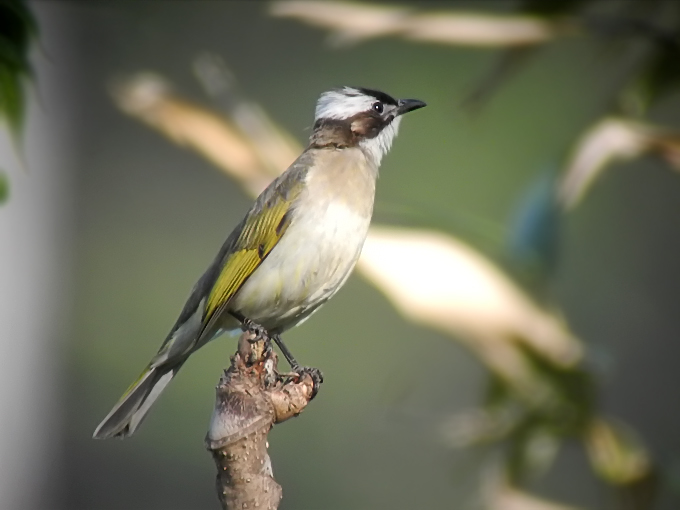
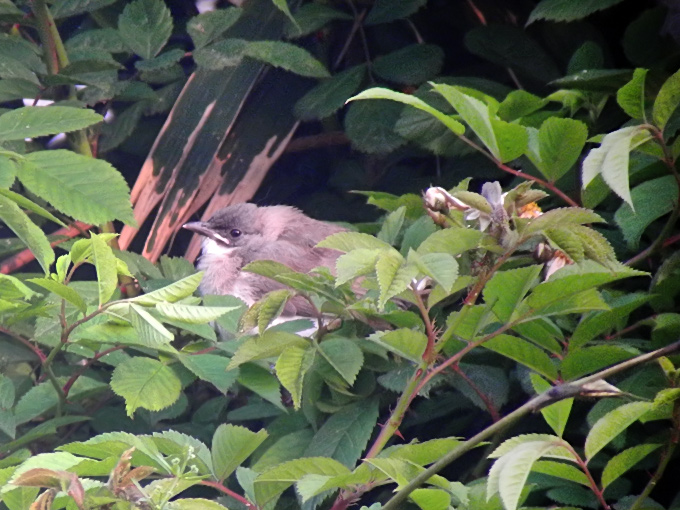
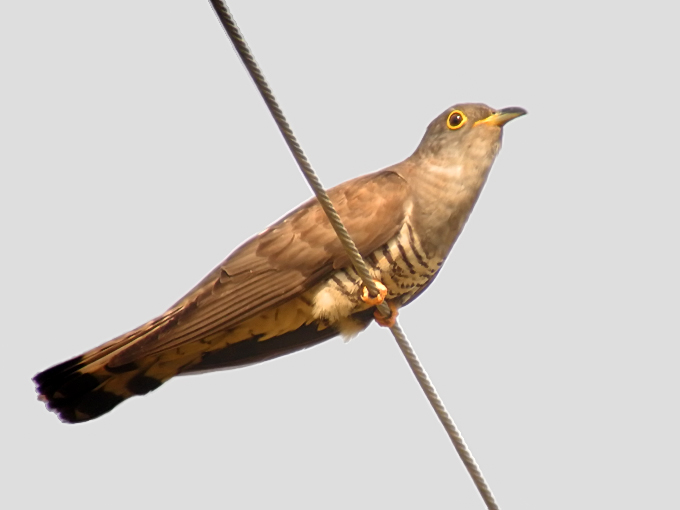
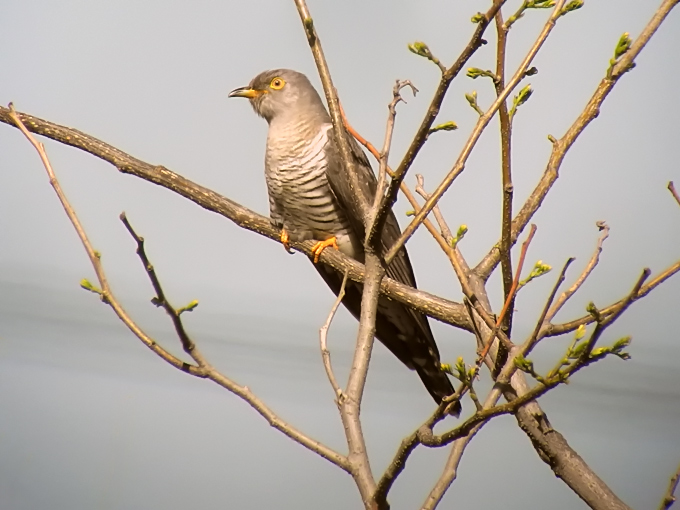
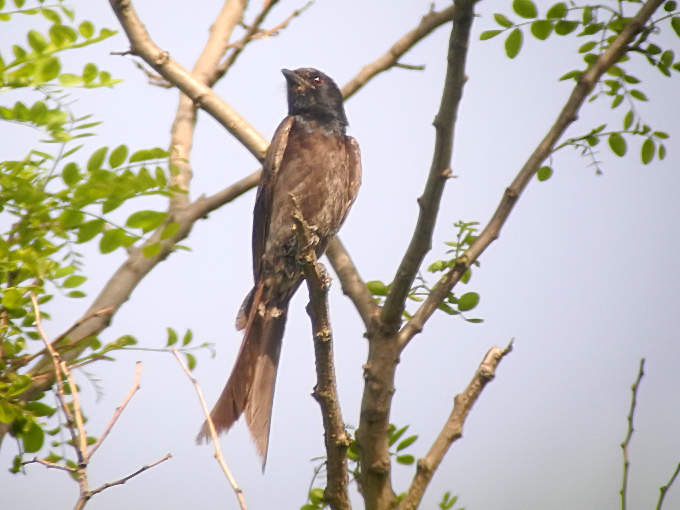
This odd-looking, very heavily-worn individual looked a little less heavily-built than the three obvious Blacks (all of which were typical Second Calendar-years) seen nearby. As the image shows, it had a retained, presumably largely juvenile plumage (worn brown and grey-brown, with a paler belly and patterned vent), though with a more adult-type head (fresh-looking black) and a few fairly glossy-looking black feathers patchily onto the breast too. Although the iris looked brownish on one side, on the other it looked more reddish. It lacked any hint of a white rictal spot (usual in Black but sometimes missing), instead having a pale gape-line (something that seems more typical of Ashy?). It also showed a suggestion of a pale line to the centre of a really long-looking tail (in spite of all of the obvious wear). To date, all of the few records of Ashy Drongo in Korea have been of the very striking white-faced leucogenis subspecies, so the default identification of dark drongos is Black (a scarce migrant here) or Hair-crested (recorded scarcely annually). Tail shape and head shape rule out Hair-crested and several features seem atypical of Black. Informed comments from experienced observers are most welcome.
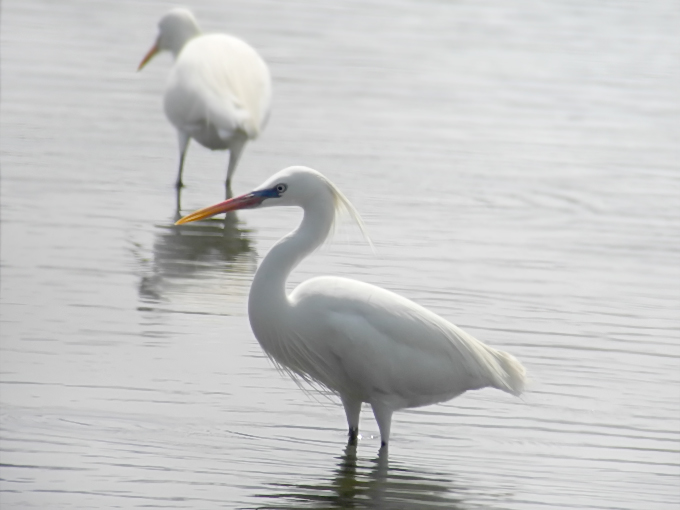

Baekryeong Island, May 26
With no boat for four days, finally arrived back on the island at 8pm on the 25th in still-dense fog. This cleared by early morning, being replaced by warm sunshine and light to moderate yellow-dust westerlies. On the 26th itself, at least 91 species logged, with a couple more – including a flock of Ruddy Turnstone heard passing overhead - late at night on the 25th). Most of the typical late migrants were present in small numbers (e.g. Black-capped Kingfisher, Oriental Dollarbird, Tiger and Brown Shrikes), with more numerous species including Eastern Cattle Egret (70+), Arctic Warbler (40+), Kamchatka Leaf Warbler (20+) and Asian Brown Flycatcher (25).
Species of most note on the 26th included single Chinese Blackbird, Black Drongo and Citrine Wagtail, a Fairy Pitta heard late in the evening, and multiple encounters with cuckoos (including perhaps 20-25 Common, five Indian and three Lesser Cuckoos and proper sightings for the first time of the unknown “barking” cuckoo of last year’s “Going Cuckoo” post, this time watched in song: more will be posted about this later). Even rarer (at least in the Korean context!) was a record-breaking group of at least 11 Himalayan Swiftlet counted in one scan late in the evening, mixed in with a group of c. 50-100 swift sp. Three Pacific Swift were positively identified; however, even closer birds simply looked all-dark and sadly had to be left unidentified – while probably half were too distant to ID even as either swift or swiftlet.
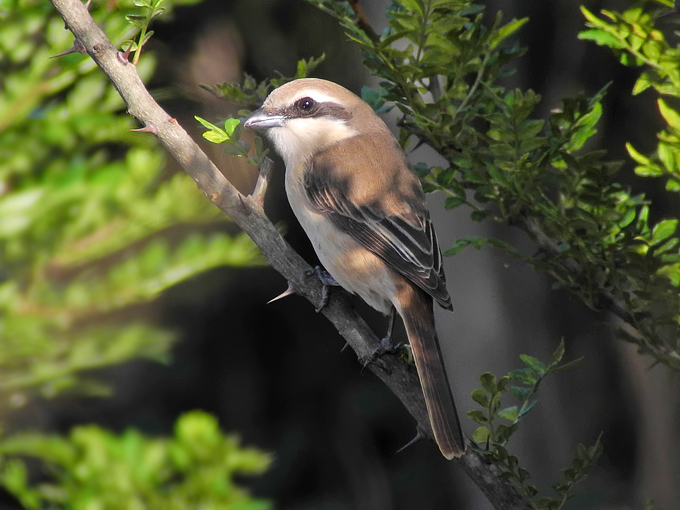
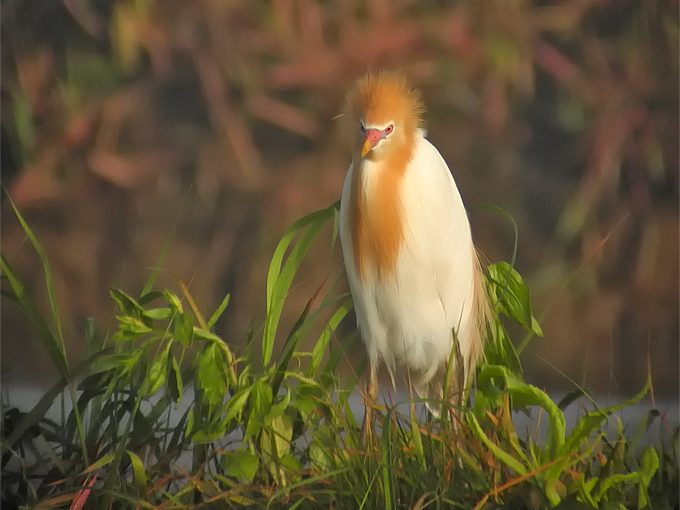
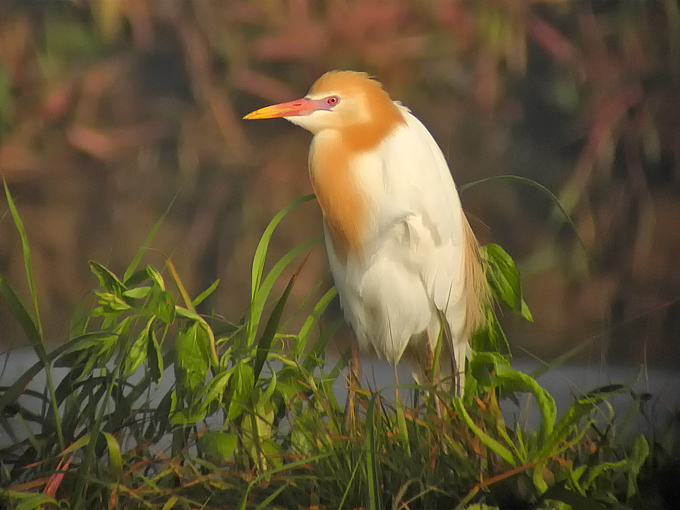
Hwacheon, May 25
An afternoon at this delightfully unspoiled area of good habitat near the DMZ produced an almost complete roll-call of Korean summer-breeders, with all the species mentioned by Robin Newlin at the same area on May 22nd present, including the Northern Scops Owl, and also with the addition of a White-backed Woodpecker, Common Kingfisher, Lesser Cuckoo, Blue-and-white Flycatcher, Marsh Tit, Varied Tit, several nests of Eastern Great Tit, Grey Wagtail, Asian Stubtail, Yellow-throated Bunting, Pale Thrush, Barn Swallow, Large-billed Crow, Rufous Turtle Dove, Tree Sparrow, and a large-ish raptor- apparently a Grey-faced Buzzard, which showed the requisite longish squared-off tail and flat-edged wings as it soared, and a glimpse of cinnamon above as it went into a steep gradual dive into the wooded hillside.
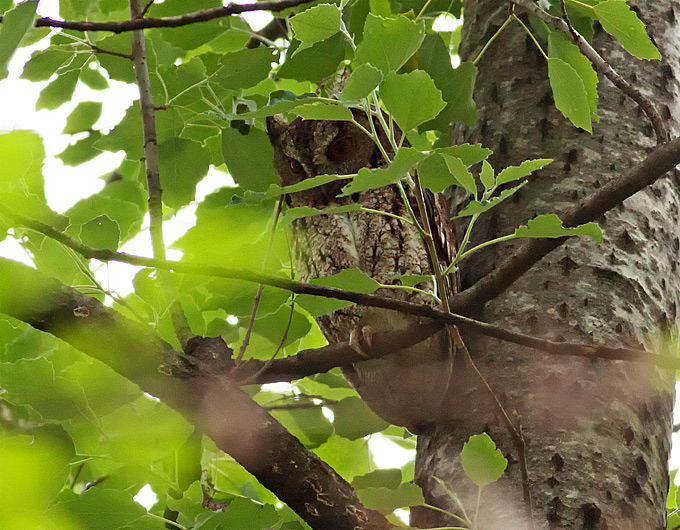
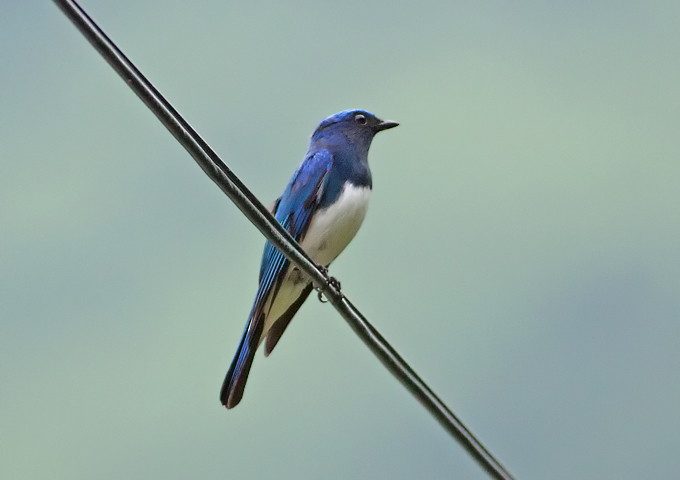
Gwangju, May 24
While on a hike through Mudeungsan National Park, Ms. Melanie Blake and I came onto a truly unexpected bird. We heard a Fairy Pitta (Pitta nympha) singing from one of the mountain valleys. We eventually tracked the bird down to a steep hill near a mountain stream, where, though it remained unseen (despite our best efforts), I was able to capture a recording of the bird singing. This is a personal first for this species in the Gwangju area; the closest I’ve located them in the past has been Jindo.
Other highlights of the day’s outing include:
- Chinese Sparrowhawk Accipiter soloensis (1; male flyover)
- Lesser Cuckoo Cuculus poliocephalus (2)
- Indian Cuckoo Cuculus micropterus (3)
- Oriental Cuckoo Cuculus optatus (2)
- Common Cuckoo Cuculus canorus (1)
- Grey Nightjar Caprimulgus jotaka (1; singing)
- Asian Stubtail Urosphena squameiceps (5)
- Dusky Warbler Phylloscopus fuscatus (1)
- White’s Thrush Zoothera aurea (2)
- Siberian Blue Robin Larvivora cyane (3)
Near Cheolweon, May 22
Birds seen (and sometimes heard) included Mandarin Duck, Northern Scops Owl, Black-naped Oriole, Oriental Dollarbird, Daurian Redstart, Grey-headed Woodpecker, Great Spotted Woodpecker and Black Woodpecker. Heard birds included Ruddy Kingfisher, Black-capped Kingfisher, Indian Cuckoo, Common Cuckoo, Oriental Cuckoo, Yellow-rumped Flycatcher, Eastern Crowned Warbler, Oriental Greenfinch and Oriental Scops Owl.
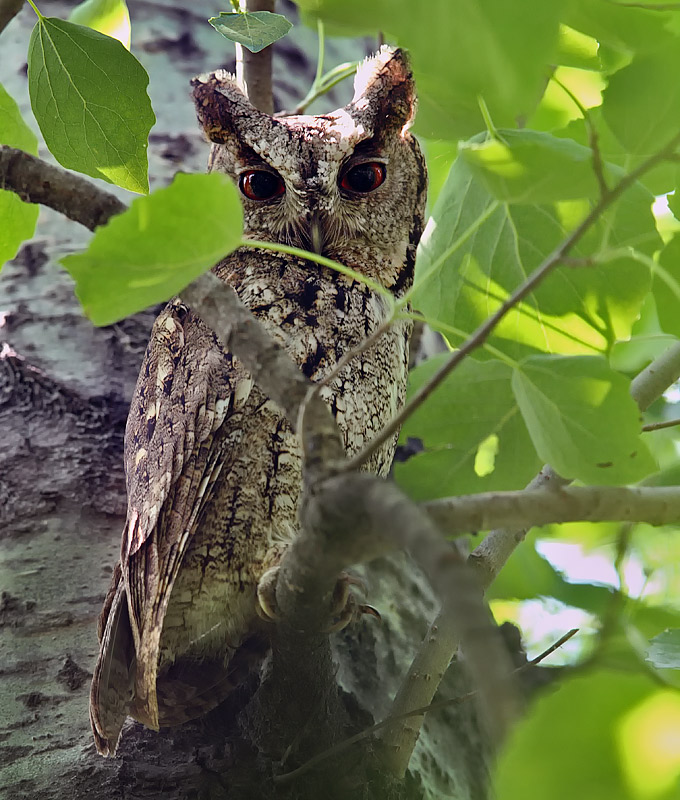
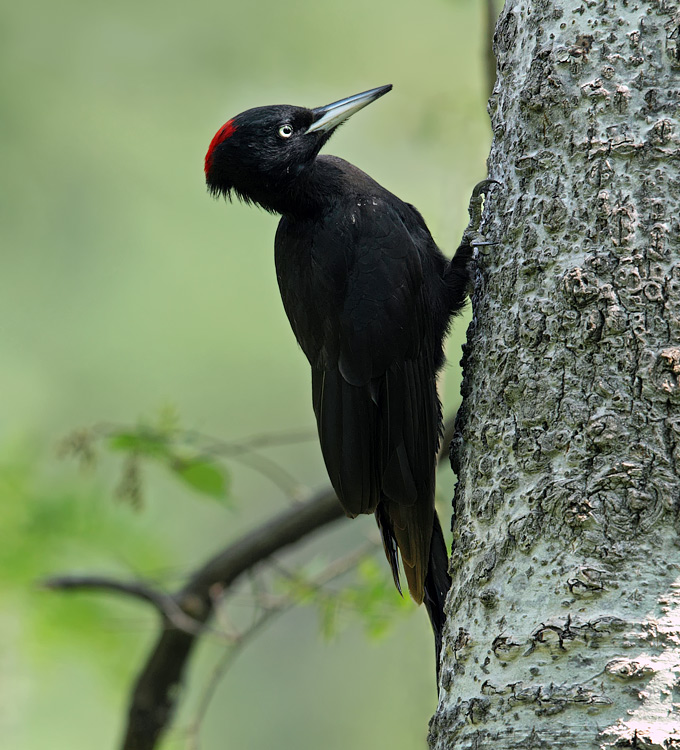
Weiyon Island, May 17 - 18
Unremarkable weather and rather few birds in evidence (especially compared to the wonderful rarities spotted last weekend). The highlight of the trip was a Large Hawk Cuckoo, a bird quite rare in Korea. It was first heard during a post dinner walk on the ‘temple hill’.The bird came and perched on a branch few feet over my head. The bird was seen well but poor light conditions mean no photos (well past sunset). I went back the following morning at dawn but inspite of close to an hour and half stakeout, the bird remained invisible (occasionally calling). Recording of the bird is here:
Other birds of note were:
- Oriental Scops Owl – At least 3 calling on ‘temple hill’ in the evening.
- presumed Japanese Leaf Warbler – Identified based on its song, once again on the ‘temple hill’ boardwalk. There were about 5 birds. One of them was seen feasting on green caterpillar.
- White-shouldered Starling – One seen flying off from the ‘pass’ at dawn.
- Black-capped Kingfisher – One seen perched on wires at the base of the hill. Even though it was well seen from a distance, it remained well out of the range of my lens but what a smartly attired bird!
- Richard’s Pipit – 5 birds seen feeding near what used to the ‘pond’.
- Forest Wagtail – 2 seen near the temple and another seen near the school.
- Eastern Yellow Wagtail – Scattered around the fields in the village, mostly taivana.
There were about a dozen Brown Shrikes and 3 Tiger Shrikes. Interestingly, a Korean gentleman photographed a Chinese Grey Shrike (a winter visitor to Korea) on May 16th, making it a very late record of this species. There were about a dozen Chinese Grosbeak and a single Japanese Grosbeak feeding on the large tree near the school.
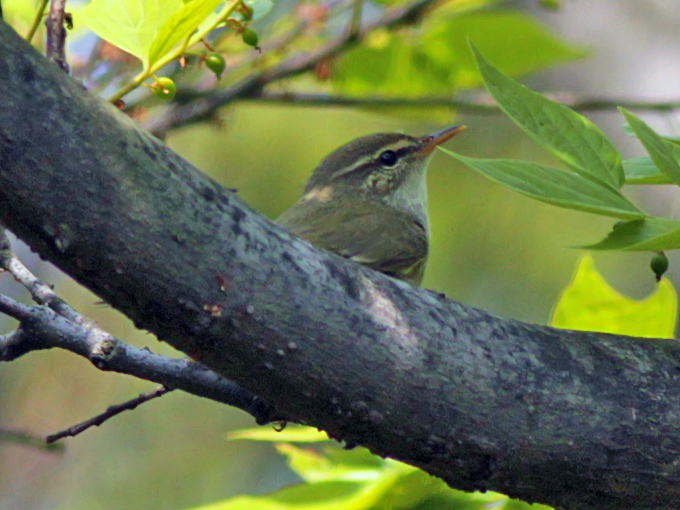
Songdo, May 16 - 18
A good variety of shorebirds on Gojan mudflats at the weekend, and reasonable tides to see them,. Highlights were 3 Asian Dowitchers on 16 May, with at least one the next day and a Nordmann’s Greenshank on 18th, the latter initially roosting with Grey Plovers before flying out to the mudflats and catching a lugworm. No Spoon-billed Sandpiper among the 200 Red-necked Stints, but I did catch up with one on an early morning trip to Yubu-do on 21st. Other shorebirds included 1,000 Dunlin, 200 each of Great Knot and Bar-tailed Godwits (both species moving on now), 30 Black-tailed Godwits (looking altogether more regal than their pot-bellied cousins), 25 Broad-billed Sandpipers, 200 Whimbrel, 30 Eastern Curlew, 200 Grey Plovers, 60 Mongolian Plovers and a few Terek Sandpipers and Ruddy Turnstones. Five Curlew Sandpipers, three Red Knots and single Grey-tailed Tattler were more unusual visitors. In the evening of the 18th, 500 Saunders’s Gull were resting on the mudflats, my highest ever count here.
Gwangju, May 17
My wife and I spent a sunny and warm afternoon in the mountains on the east side of Gwangju. There were many signs of nesting around, including a Pale Thrush nest with five chicks, estimated to be about 2-3 days old. Daurian redstarts were also productive, with three recent fledglings observed with an adult male. New arrivals, like Black-naped Oriole and Oriental Dollarbird are quite vocal, and a few migrants are still about, such as a single Tristram’s Bunting (the first I’ve seen in the Gwangju area).
Despite being well into the afternoon, no less than four Oriental Scops Owls were heard. A little patience and persistence finally revealed one of them in a small cluster of deciduous trees. Photos and recordings were taken.

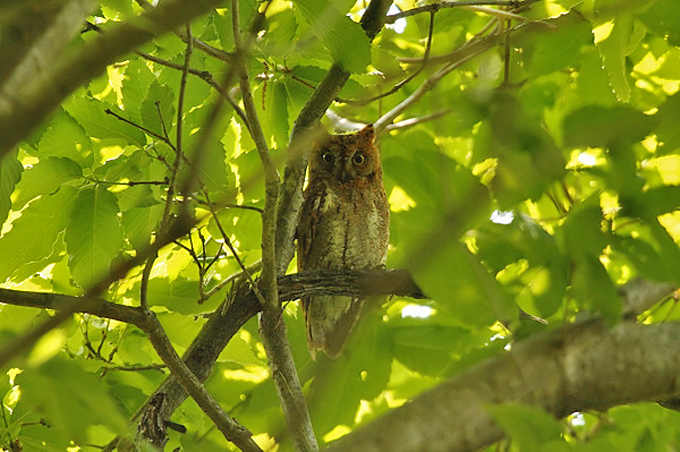
Hwaseong, May 15
Mr. Im and I drove out to catch a reasonably high tide at Hwaseong’s wader roost. There we met up with Mr. Jo Sung Sik, very familiar with Hwaseong’s birds, Ms. Kang Ji-hae, and (quite by lucky chance) Dr. Shim Kyu Sik—each and all drawn to that spot by the confluence of time, tides and birds. Highlights from the tidal flat and nearby rice-fields and waterways: 3 Black-winged Stilts, a sleeping Black-faced Spoonbill; rough estimates of 3 thousand Great Knots, 2 thousand Dunlin, 200 Far-Eastern Curlews, 150 Black-tailed Godwits, 200 Bar-tailed Godwits, 40 Mongolian Plovers, 80 Grey Plovers, 20 Sharp-tailed Sandpipers; scattered Kentish Plovers, Red-necked Stints, and Terek Sandpipers; 20 cracking Red Knots and 5 breeding-plumage Curlew Sandpipers. Outstanding highlight, along with 10 or so Common Greenshanks, 3 Nordmann’s Greenshanks before most of the flock was put up and remixed by a pair of passing Eurasian Kestrels.
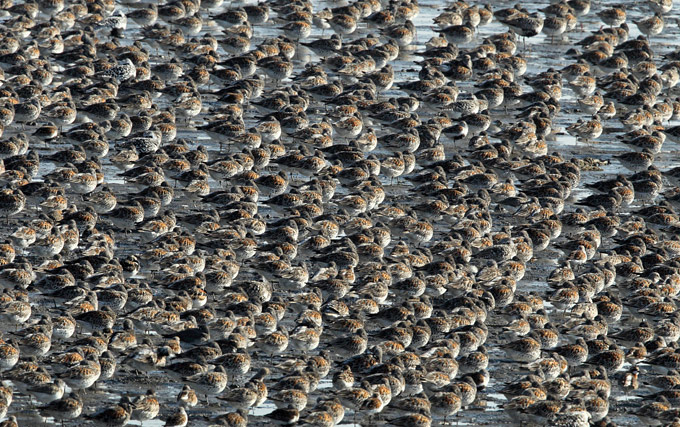

Han River, May 10
Early on Saturday I caught up with N.M. and J.L. (good to finally meet!) who had already found a Black Woodpecker, and we visited the Eastern Tawny Owls: an adult fairly high in a tree and a fuzzy juvenile even higher up. Black-naped Orioles and Eurasian Nuthatches called in the background, and a pair of Mandarin Ducks adorned a nearby tree.

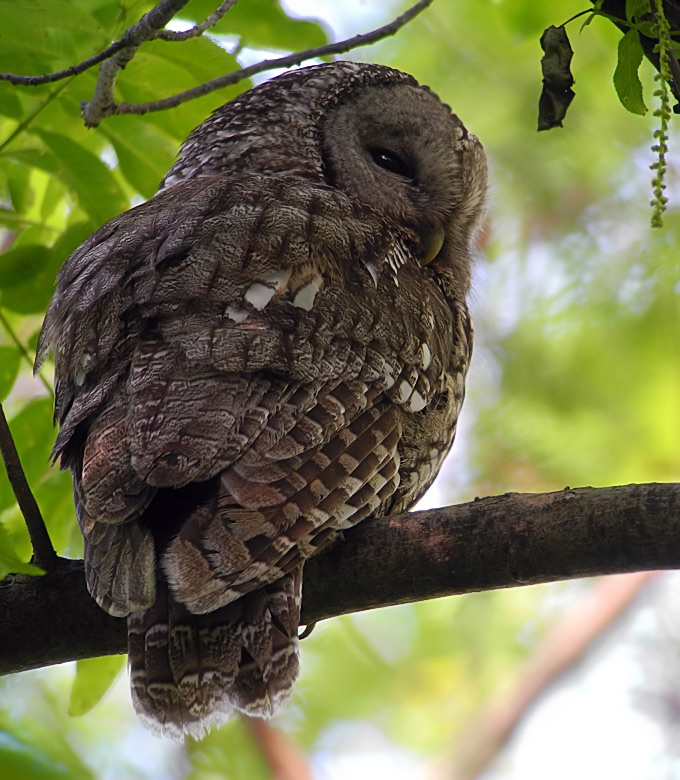
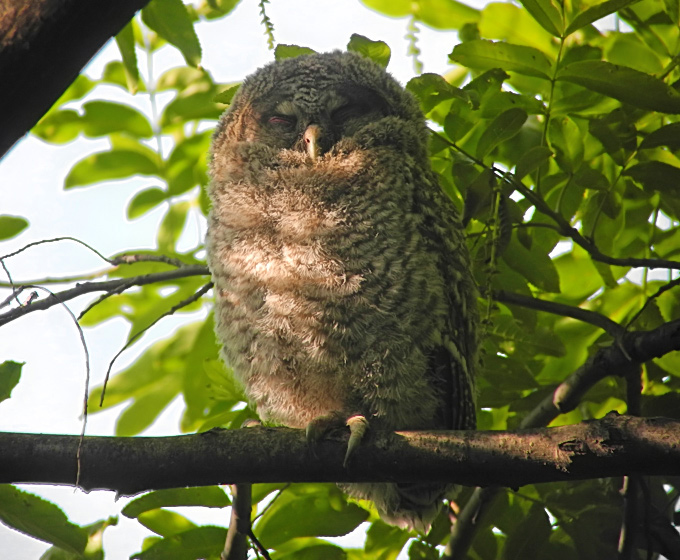
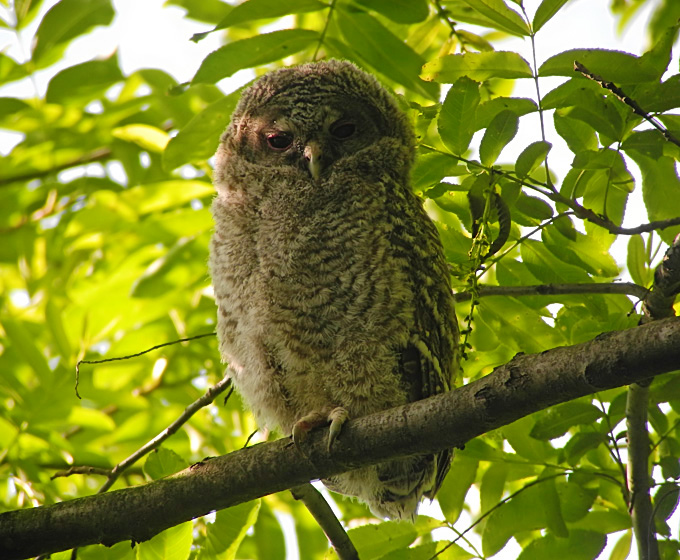
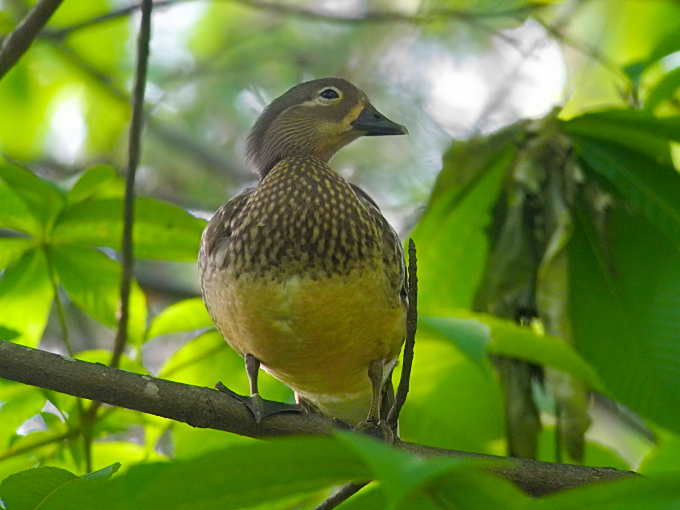
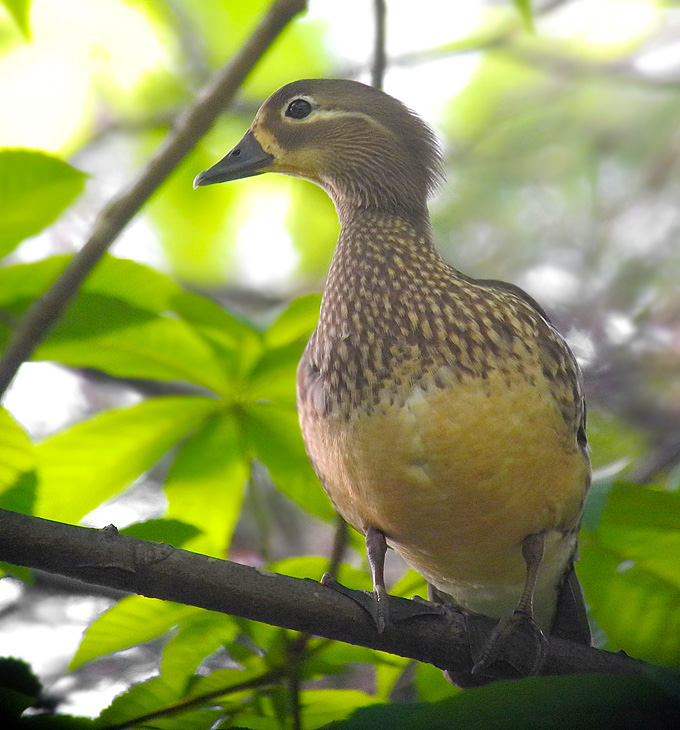
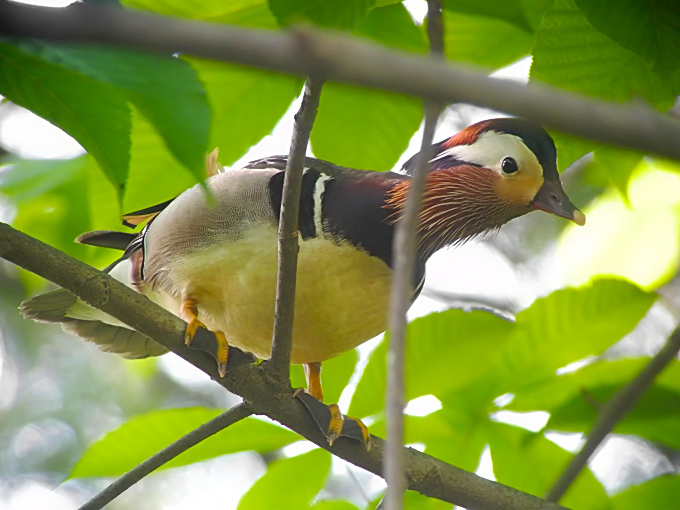
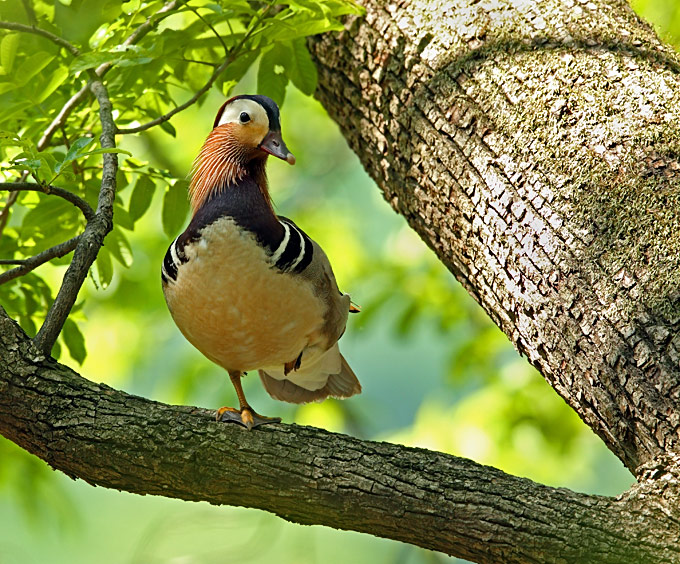
Weiyon Island, May 9 - 10
Species list:
- Chinese Pond Heron Ardeola bacchus
- Eastern Cattle Egret Bubulcus coromandus
- Grey Heron Ardea cinerea
- Great Egret Ardea alba
- Eastern Great Egret A. m. modesta
- Intermediate Egret Egretta intermedia
- Japanese Cormorant Phalacrocorax capillatus
- Eurasian Hobby Falco subbuteo
- Chinese Sparrowhawk Accipiter soloensis
- Northern Goshawk Accipiter gentilis
- Black-tailed Gull Larus crassirostris
- (Rock Dove) Columba livia
- Oriental Turtle Dove Streptopelia orientalis
- Common Cuckoo Cuculus canorus
- Oriental Cuckoo Cuculus optatus
- Oriental Scops Owl Otus sunia
- Northern Boobook Ninox japonica
- Grey Nightjar Caprimulgus jotaka
- Pacific Swift Apus pacificus
- House Swift Apus nipalensis
- Oriental Dollarbird Eurystomus orientalis
- Eurasian Wryneck Jynx torquilla
- Great Spotted Woodpecker Dendrocopos major
- Ashy Minivet Pericrocotus divaricatus
- Bull-headed Shrike Lanius bucephalus
- Brown Shrike Lanius cristatus
- Black-naped Oriole Oriolus chinensis
- Eurasian Magpie Pica pica
- Japanese Tit Parus minor
- Barn Swallow Hirundo rustica
- Red-rumped Swallow Cecropis daurica
- Long-tailed Tit Aegithalos caudatus
- Brown-eared Bulbul Hypsipetes amaurotis
- Asian Stubtail Urosphena squameiceps
- Manchurian Bush Warbler Horornis borealis
- Japanese Bush Warbler Horornis diphone
- Dusky Warbler Phylloscopus fuscatus
- Radde's Warbler Phylloscopus schwarzi
- Pallas's Leaf Warbler Phylloscopus proregulus
- Yellow-browed Warbler Phylloscopus inornatus
- Kamchatka Leaf Warbler Phylloscopus examinandus
- Arctic Warbler Phylloscopus borealis
- Pale-legged Leaf Warbler Phylloscopus tenellipes
- Eastern Crowned Warbler Phylloscopus coronatus
- Red-billed Starling Spodiopsar sericeus
- White-cheeked Starling Spodiopsar cineraceus
- Siberian Thrush Geokichla sibirica
- Grey-backed Thrush Turdus hortulorum
- Japanese Thrush hortulorum
- Common Blackbird Turdus merula
- Eyebrowed Thrush Turdus obscurus
- Pale Thrush Turdus pallidus
- Brown-headed Thrush Turdus chrysolaus
- Siberian Rubythroat Calliope calliope
- Rufous-tailed Robin Larvivora sibilans
- Red-flanked Bluetail Tarsiger cyanurus
- Stejneger's Stonechat Saxicola stejnegeri
- Isabelline Wheatear Oenanthe isabellina
- Blue Rock Thrush Monticola solitarius
Subspecies: M. s. pandoo - Grey-streaked Flycatcher Muscicapa griseisticta
- Dark-sided Flycatcher Muscicapa sibirica
- Asian Brown Flycatcher Muscicapa latirostris
- Ferruginous Flycatcher Muscicapa ferruginea
- Yellow-rumped Flycatcher Ficedula zanthopygia
- Narcissus Flycatcher Ficedula narcissina
- Mugimaki Flycatcher Ficedula mugimaki
- Taiga Flycatcher Ficedula albicilla
- Blue-and-white Flycatcher Cyanoptila cyanomelana
- Eurasian Tree Sparrow Passer montanus
- Forest Wagtail Dendronanthus indicus
- Eastern Yellow Wagtail Motacilla tschutschensis
Subspecies: M. t. taivana
Subspecies: M. t. tschutschensis
Subspecies: M. t. macronyx - Grey Wagtail Motacilla cinerea
- Richard's Pipit Anthus richardi
- Olive-backed Pipit Anthus hodgsoni
- Red-throated Pipit Anthus cervinus
- Buff-bellied Pipit Anthus rubescens
- Brambling Coelebs montifringilla
- Hawfinch Coccothraustes coccothraustes
- Chinese Grosbeak Eophona migratoria
- Meadow Bunting Emberiza cioides
- Tristram's Bunting Emberiza tristrami
- Little Bunting Emberiza pusilla
- Yellow-browed Bunting Emberiza chrysophrys
- Yellow-breasted Bunting Emberiza aureola
- Chestnut Bunting Emberiza rutila
- Yellow Bunting Emberiza sulphurata
- Black-faced Bunting Emberiza spodocephala
- Common Reed Bunting Emberiza schoeniclus
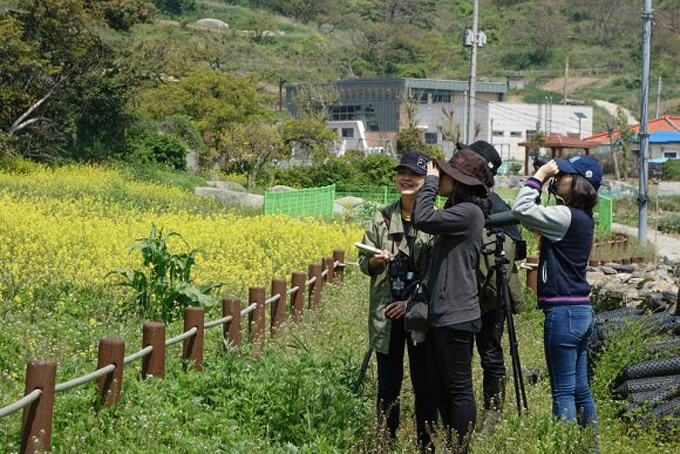
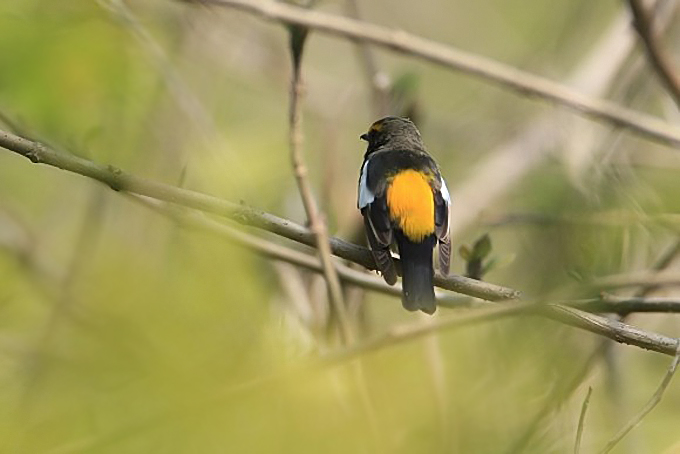
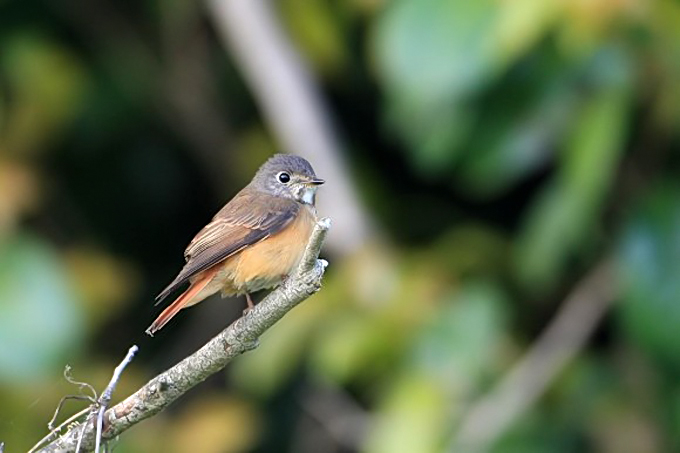
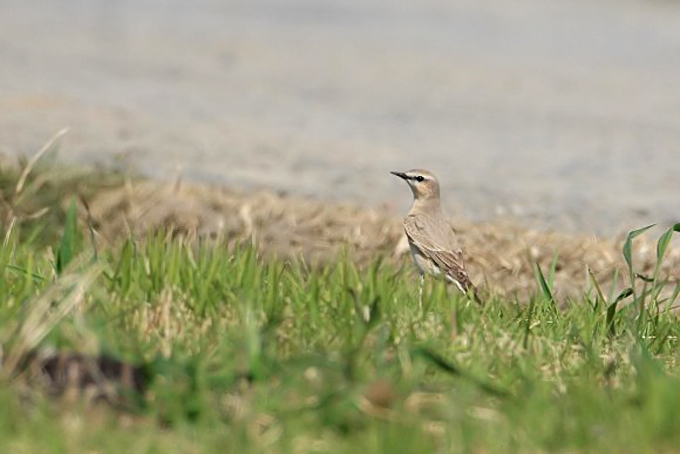
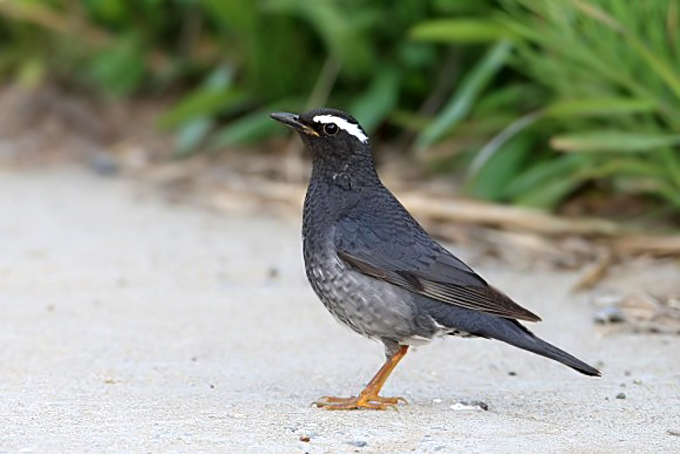
Han River, May 10
In an area of broad-leaved riverine forest, an adult Eastern Tawny Owl and three owlets. They have bred here for the past two years at least, and presumably benefit from the islets isolation and resulting lack of land-based predators, the fact pesticides have apparently never been used locally, and the old trees and areas of overgrown grass. These owls are extraordinarily difficult to spot as they loaf in the high canopy. The chicks, having been hatched at intervals, show markedly different stages of development.
Other birds here included e.g. Oriental Dollarbird, Chinese Grosbeak, Yellow-rumped Flycatcher and Great Spotted Woodpecker; non avian creatures included a Red Squirrel and Siberian Chipmunk.
Also present a nesting pair of Black Woodpecker, which are remarkably slow-flying and crow-like. Near the nest they are silent and the male and female make alternate visits every 20 minutes or so. Also in the vicinity, one or two abandoned trial nest holes had been chiselled into less preferred trees.
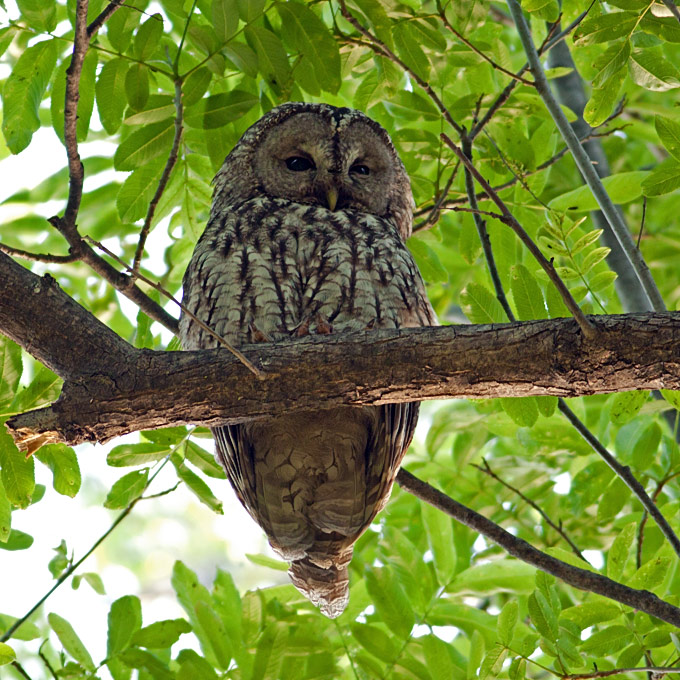
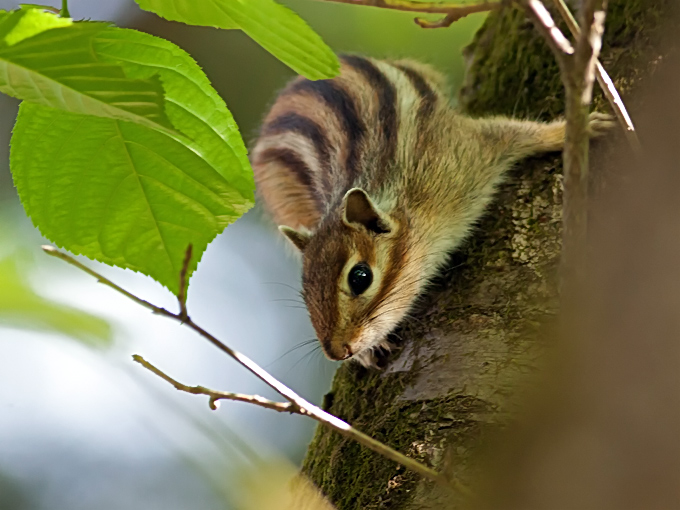
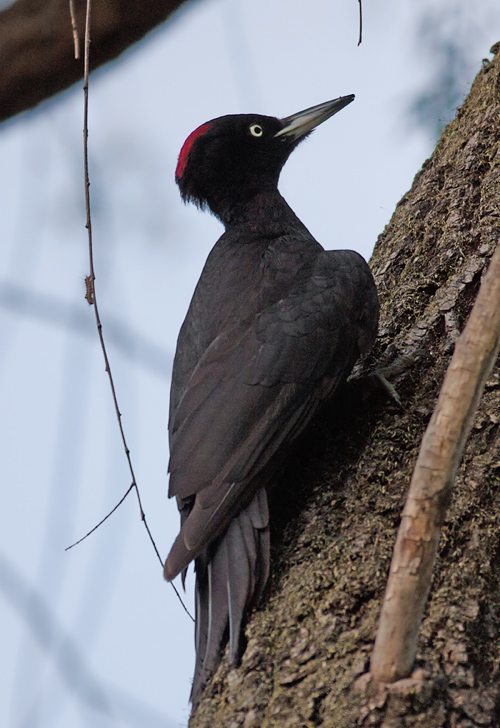
Baekryeong Island, Incheon, April 25 - May 9
I visited Baekryeong Island again from April 25th (arriving in the afternoon) to May 9th (departing at 2pm). I was joined on several dates in early May by Prof. Robert Newlin (RN) and on May 5th by Mr. Tim Edelsten (TE).
The main research aims included trying to determine if some species of landbird likely cross Ongjin County on a broad or narrow front (in particular, the three ROK islands of Baekryeong, Daecheong and Socheong; and western Hwanghaenam Province, DPRK); and trying to improve understanding of the effects of weather and source-winds on the numbers of birds that are recorded. Such a baseline understanding is important in interpreting data sets, and in trying to identify population trends in some of these species.
Throughout this survey period, efforts were especially focused on areas of fields and woodland edge in the northeast; and in arable and woodland edge in the far southwest of the island (at Junghwadong). Further observations and counting (of all birds heard and seen, irrespective of distance) were also conducted on three or more dates in the marsh at Hwadong (“Hwadong Wetland”); at Sagot Village in the south; and at Yeonhwa Village in the west. Several visits were also made to an especially large Black-tailed Gull colony kindly introduced to me by one of the islanders.
In total, 195 bird species were recorded, with species of most note including six or seven Black-faced Spoonbill, one (or more probably two) Saker Falcon, Korea’s first Mongolian Lark, one or two Alpine Leaf Warblers, two singing Yellow-streaked Warblers, a singing Sakhalin Leaf Warbler, a Wheatear sp., two Tree Pipit together and presumed national high day-counts of e.g. Yellow-browed Bunting.
For the full report, please go here.

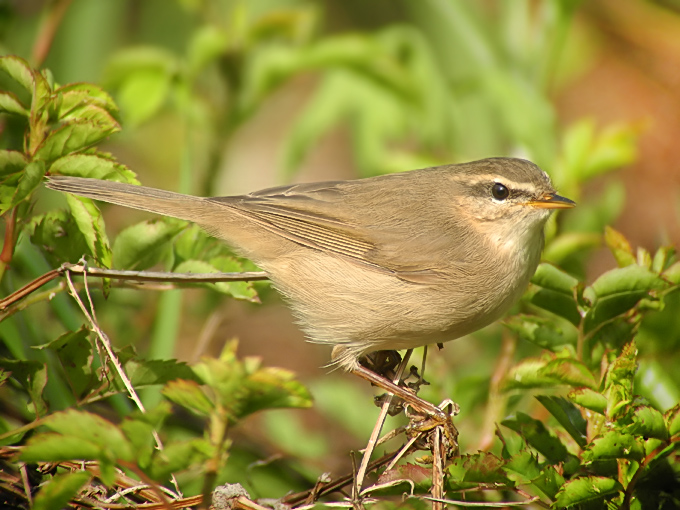
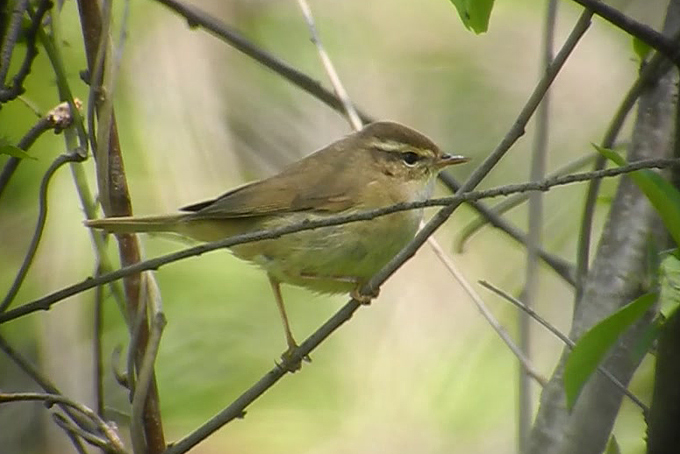
Han River, May 8
A visited to a wooded riverside area yielded 4 Mandarin Ducks perched high in the trees, a Yellow-rumped Flycatcher, a Eurasian Nuthatch, a calling Oriental Scops Owl, and 1 adult and 2 fledgling Eastern Tawny Owls.
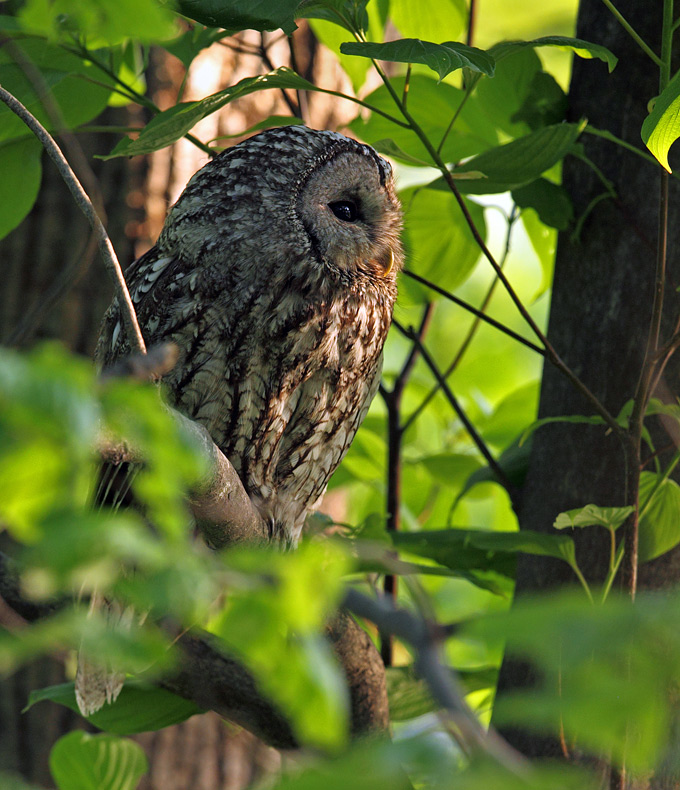
Baekryeong Island, Incheon, May 3 - 7
Since my 5 days on the island fall within the period Dr. Moores’ stay, and to avoid redundancy, the following account lists a few highlights and then gives a full list of birds species seen during my Birdathon effort.
Highlights. The rarities discovered by N.M.—Alpine Leaf Warbler, Tree Pipit, and Mongolian Lark. The surprisingly good numbers of some generally scarce birds, e.g. Yellow-browed Bunting, Yellow-breasted Bunting, and Taiga Flycatcher. Excellent numbers of Olive-backed Pipits, Little Buntings, Chinese Grosbeaks, and Eyebrowed Thrushes. A pair of Northern Boobook—one seen and one heard. A calling Oriental Scops Owl. The amazing Black-tailed Gull colony and the Black-faced Spoonbills. Toward the end of my stay, a single small tree held 4 very active Mugimaki Flycatchers, 1 Asian Brown Flycatcher, 2 Yellow-browed Warblers and a stop-by Radde’s Warbler.
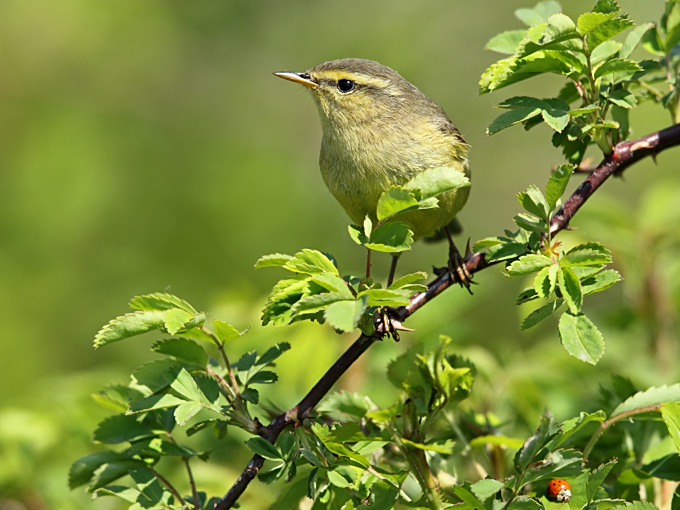
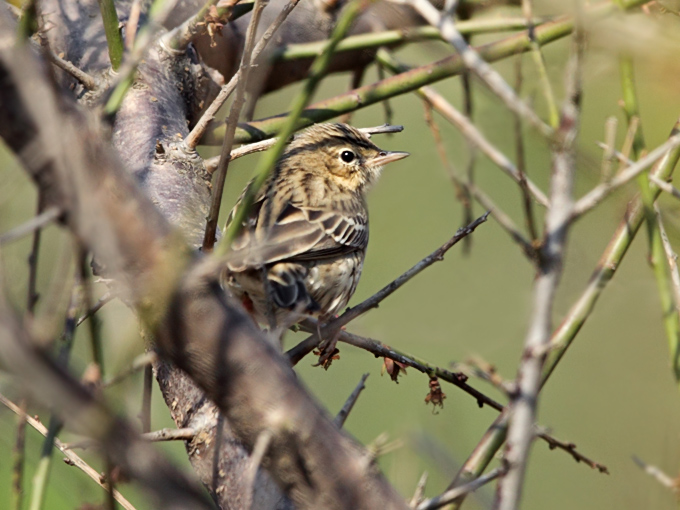
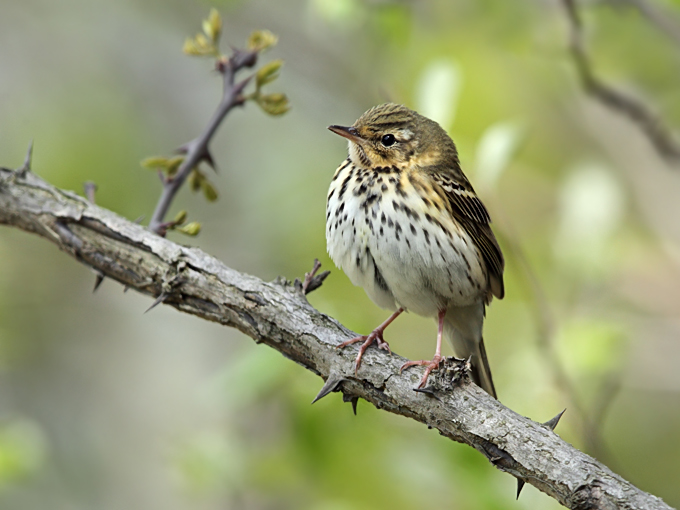
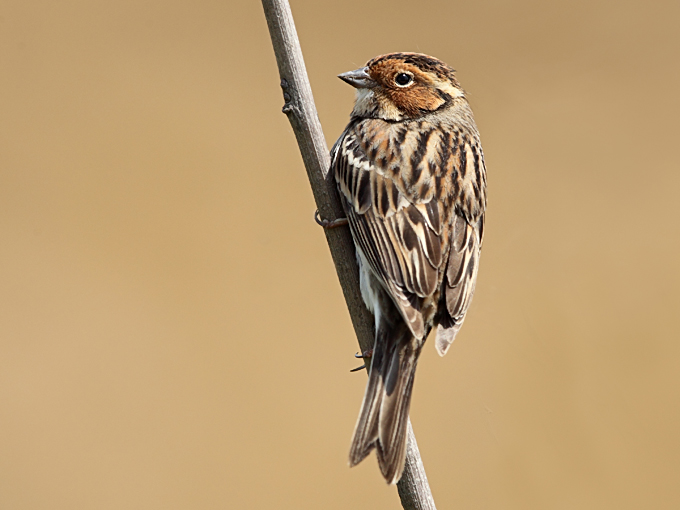
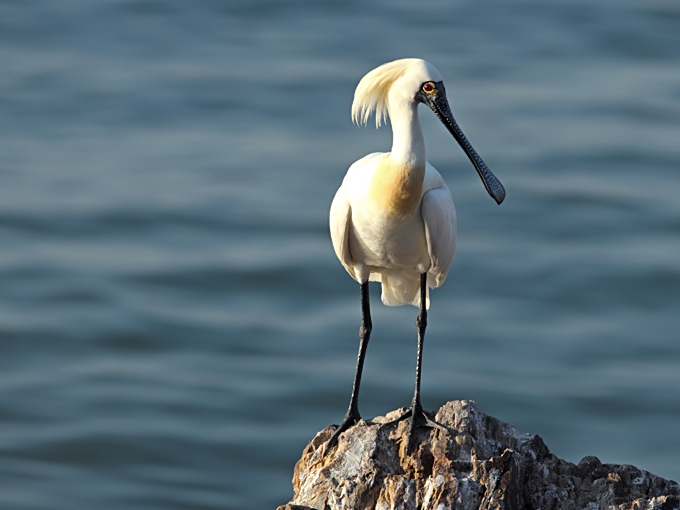

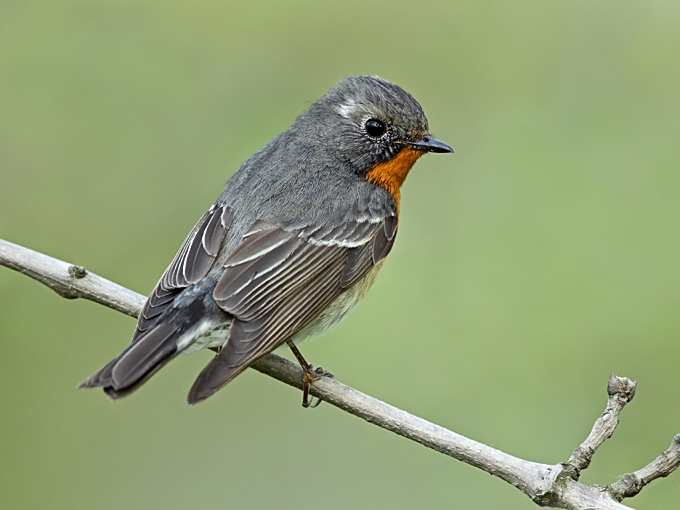
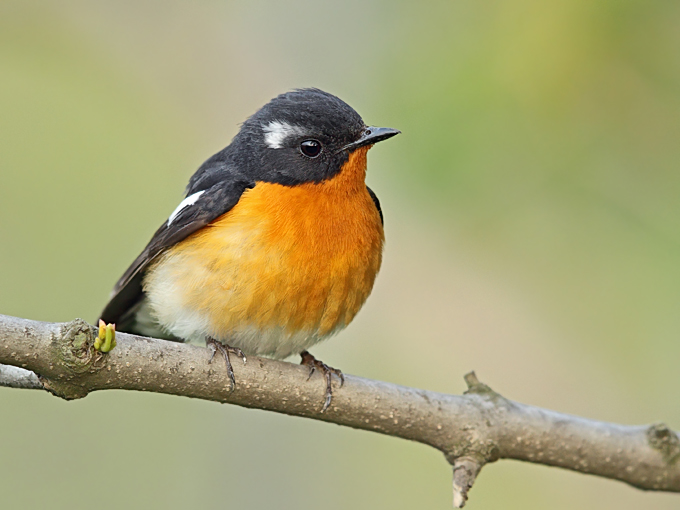
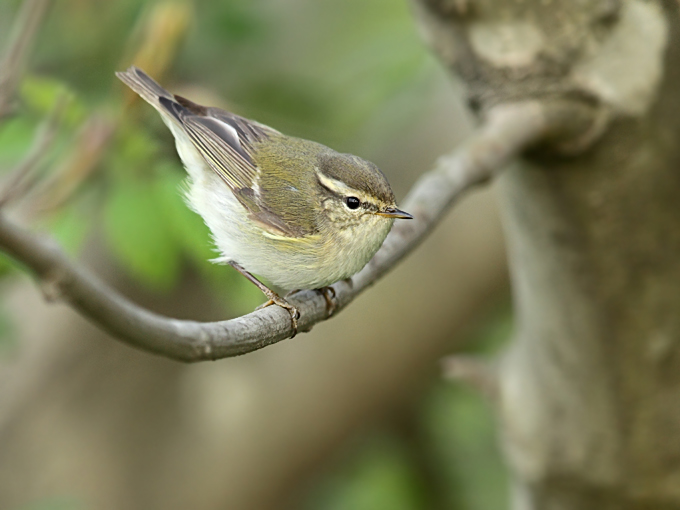
Birdathon: May 4. Species noted by R.N. only during time (limited by rain and other factors) walking slowly around Nonghyup and Sagotri. 70 species. Many thanks to H, J, and L for sponsorship of a very important and worthwhile cause!
- Eastern Spot-billed Duck, 4
- Common Pheasant, 3
- Black-crowned Night Heron, 2
- Striated Heron, 1
- Chinese Pond Heron, 2
- Eastern Cattle Egret, 3
- Grey Heron, 6
- Great Egret, 2
- Intermediate Egret, 1
- Little Egret, 1
- Great Cormorant, 3
- Japanese Sparrowhawk, 1
- Little Ringed Plover, 1
- Green Sandpiper, 2
- Black-tailed Gull, 30
- Oriental Turtle Dove, 2
- Oriental Scops Owl, 1
- Black-capped Kingfisher, 1
- Common Kingfisher, 1
- Eurasian Hoopoe, 1
- Peregrine Falcon, 1
- Eurasian Hobby, 1
- Ashy Minivet, 5
- Brown Shrike, 3
- Black-naped Oriole, 4
- Eurasian Jay, 7
- Large-billed Crow, 2
- Eastern Great Tit, 2
- Light-vented Bulbul, 8
- Brown-eared Bulbul, 5
- Pale Martin, 1
- Barn Swallow, 5
- Korean Bush Warbler, 2
- Dusky Warbler, 4
- Yellow-browed Warbler, 8
- Eastern Crowned Warbler, 1
- Chestnut-flanked White-eye, flock heard
- Grey-backed Thrush, 1
- Eyebrowed Thrush, 2—more heard
- White’s Thrush, 1 seen, other heard
- Dusky Thrush, 1
- Grey-streaked Flycatcher, 2
- Asian Brown Flycatcher, 4
- Blue and White Flycatcher, 2.
- Siberian Blue Robin, 1
- Rufous-tailed Robin, a few heard
- Siberian Rubythroat, a few heard
- Red-flanked Bluetail, 1
- Yellow-rumped Flycatcher, 3
- Taiga Flycatcher, 6
- Blue Rock Thrush, 2
- Stejneger’s Stonechat, 8
- Eurasian tree Sparrow,12
- Eastern Yellow Wagtail, 2
- White Wagtail, 5
- Richard’s Pipit, 1 heard
- Olive-backed Pipit, 19
- Brambling, 12
- Hawfinch, 1
- Chinese Grosbeak, 7
- Grey-capped Greenfinch, 12
- Eurasian Siskin, 20
- Yellow-browed Bunting, 35
- Yellow-throated Bunting, 1
- Little Bunting, 30
- Yellow-breasted Bunting, 4
- Chestnut Bunting, 2
- Tristram’s Bunting, 2
- Chestnut-eared Bunting, 1
- Black-faced Bunting, 7
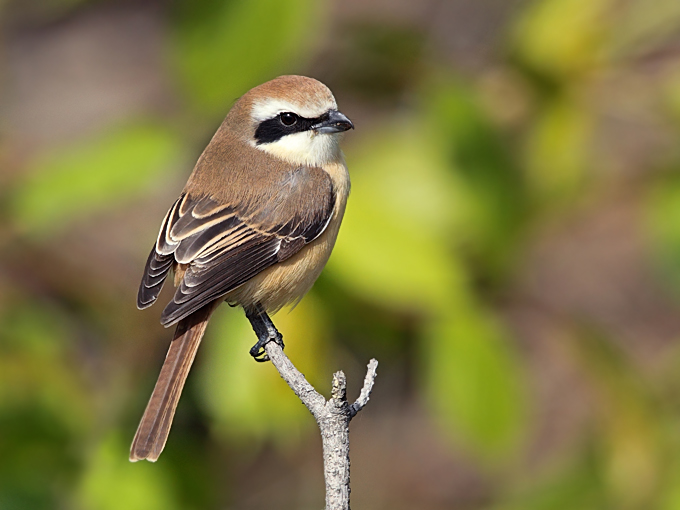
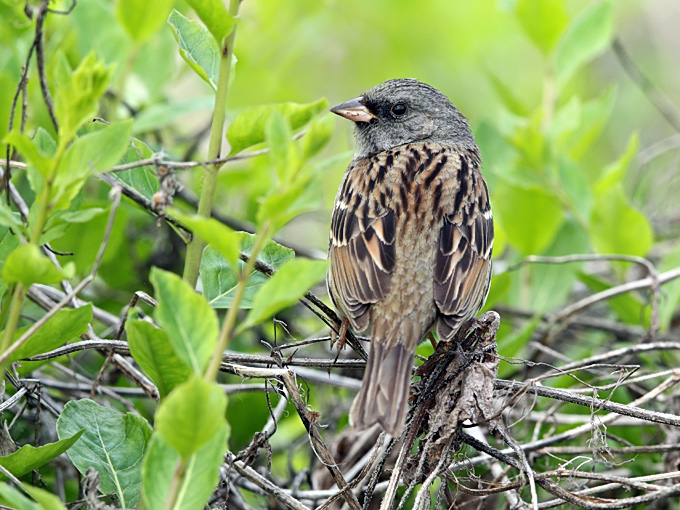
Hado-ri, Jeju, May 7
At Hado, a gorgeous Pied Avocet fed in the company of three Black-winged Stilts, and 33 Black-tailed Godwits. I got long, if distant looks as it fed by swimming and upending repeatedly. Also at Hado, and nearby Ojo-ri, were single-digit numbers of Marsh, Common, and Wood Sandpiper, Common Greenshank, Common Redshank and Falcated Duck.
Several Rufous-tailed Robins have been heard in Seogwipo over the past few days, and several Tristram’s Buntings and a male Mugimaki Flycatcher were seen in local parks.
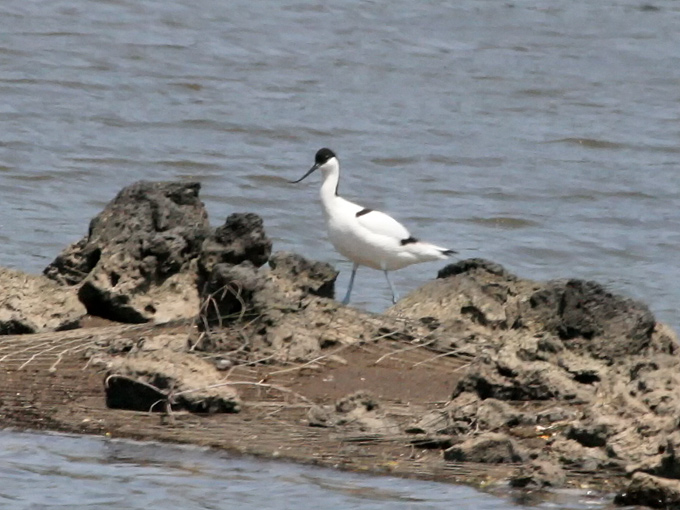
Baekryeong Island, Incheon, May 6
After several excellent days in the field on Baekryeong Island (more of which will be posted later!), a fair-weather arrival on the 6th produced a rapid increase in some species (most especially Yellow-browed Warbler, Little and Yellow-breasted Bunting, with c. 100 of the latter globally Endangered species present in only a small part of the island that was surveyed); a wheatear sp.,seen only in high flight; and most exceptional of all, a stunning Mongolian Lark Melanocorypha mongolica. Found and photographed initially by NM in the early evening, the bird was also soon after seen and photographed by RN. Better images of this first record for the ROK are therefore likely to come soon...

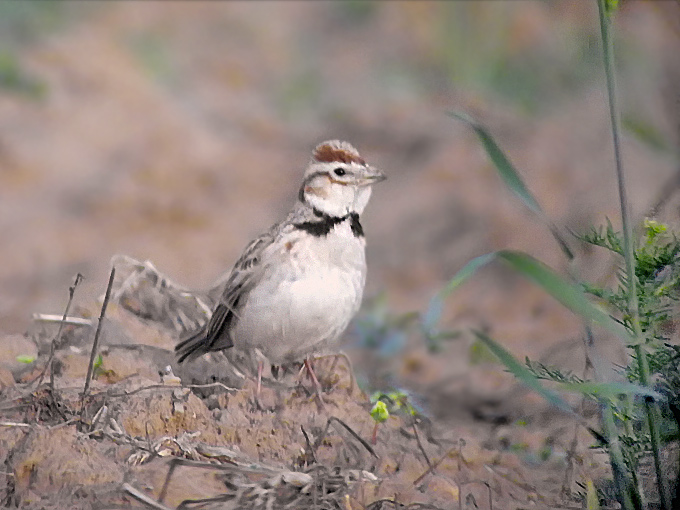
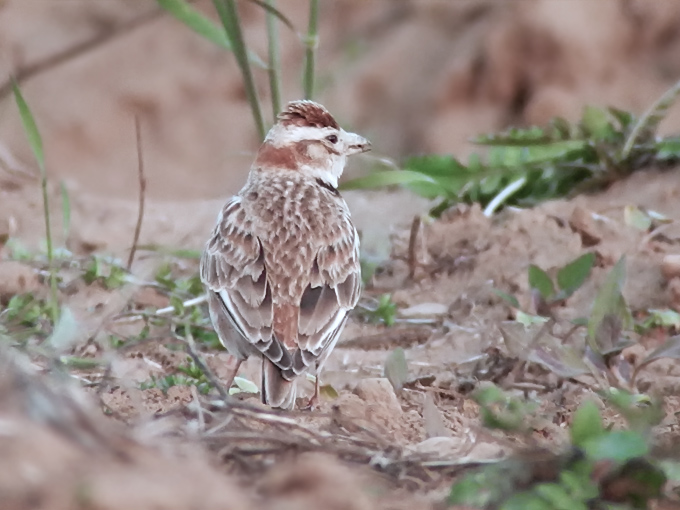
Baekryeong Island, Incheon, May 5
Under bright blue skies and cool winds, a nice selection to be seen, notably in the far southeast. Of most significance, a very approachable Alpine Leaf Warbler- only the 10th national record- found a day earlier by Nial Moores. This individual returned repeatedly to the same low bushes where it fed very actively and restlessly, quite unconcerned at being observed from only feet away. Very agile, it inched and darted along and under leaves and branches. It called occasionally, a soft sibillant chirruping- somewhat sparrow-like but also with a harder resonant quality, as of a stonechat.
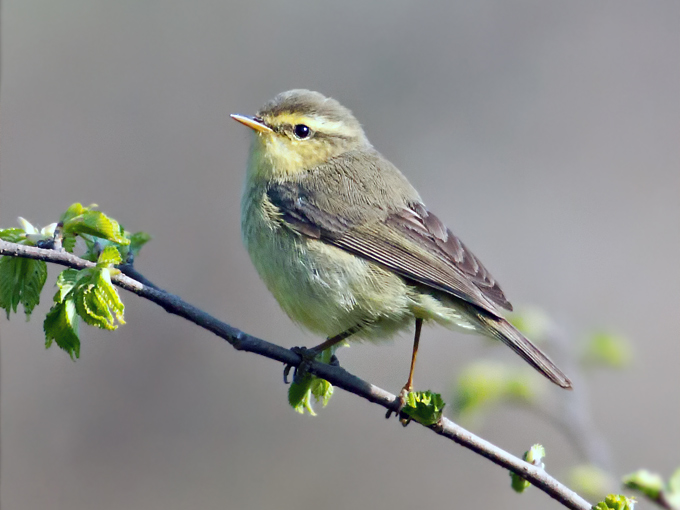
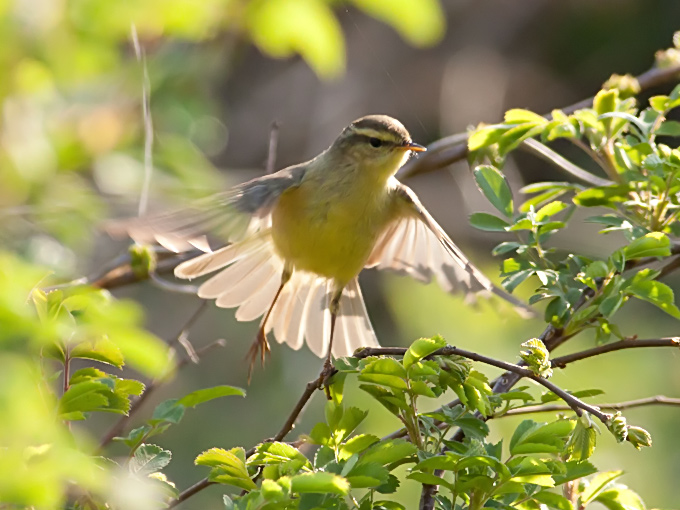
Only minutes later two Tree Pipit - a very scarce migrant- were seen feeding together in a vegetable field: apparently the first national record of multiple arrival. These were a very plain, even sandy-grey, they merge imperceptibly with their background have a low-slung look, creeping along with a sort of meticulous gravity, quite wary and usually partially obscured by a tussock of grass or vegetation.
Other birds of varying interest included two Japanese Quail (TE only), a Chinese Egret (TE only), a Common Moorhen (NM only), a nesting pair of Far Eastern Oystercatcher, one Mongolian Gull among the large breeding colony of Black-tailed Gull, a Common Kingfisher, four or five Eurasian Wryneck, 10+ Light-vented Bulbul on territory, plentiful singing Korean Bush Warbler, several Eurasian Jay, a few caudata Long-tailed Tit, a flock of Chestnut-flanked White-eye, singing White's Thrush, 10+ singing Rufous-tailed Robin, a Bluethroat, several Siberian Rubythroat (singing and also emitting characteristic piercing calls and low gruff 'barks'), an unusual Daurian Redstart with striking white crown, a Russet Sparrow (NM only) along with Eurasian Tree Sparrows, a late flock of Brambling, 7 Red Crossbill, a Blyth's Pipit, 40+ Little Bunting, only two Yellow-breasted Bunting, four Yellow-browed Bunting and two Blue-and-White Flycatcher.
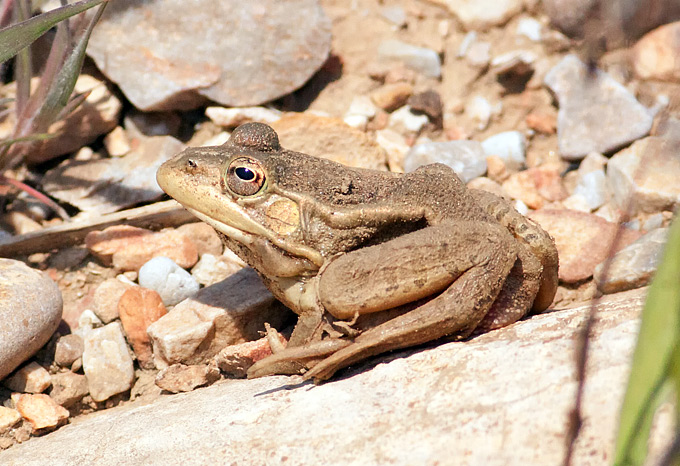
Also of note, a Dark-spotted Frog - this somewhat variable species seems widespread on west coast islands. Also, sadly, a struggling Olive-backed Pipit was found trapped in a sticky mass of discarded tar, apparently left from the building that used to stand on the site. Is there no end to the number of lethal man-made hazards that birds must now navigate?
Eocheong Island, May 4 (14:20) – May 5 (14:20)
Fortunately, this year’s Birdathon stretched through a short holiday season, allowing me to have a few days on Eocheong Island. It was my first time in two years entering the Birdathon as an individual. It was a different experience to be only on foot, certainly a new aspect of the race I thoroughly enjoyed. The weather was good and the island seemed quite birdy from day one. I feel very satisfied with the results, 93 species. I even picked up a few lifers (4)! Here are my results:
- Cinnamon Bittern Ixobrychus cinnamomeus, 1
- Striated Heron Butorides striata, 1, including 3 seen from the ferry
- Chinese Pond Heron Ardeola bacchus, 2, male and female
- Eastern Cattle Egret Bubulcus coromandus, 7
- Grey Heron Ardea cinerea, 5
- Great Egret Ardea alba, 1
- Intermediate Egret Egretta intermedia, 3
- Great Cormorant Phalacrocorax carbo, 4
- Northern Goshawk Accipiter gentilis, 1
- Black-winged Stilt Himantopus himantopus, 3
- Common Snipe Gallinago gallinago, 1
- Pintail Snipe Gallinago stenura, 1
- Common Greenshank Tringa nebularia, 2
- Green Sandpiper Tringa ochropus, 1
- Wood Sandpiper Tringa glareola, 4
- Grey-tailed Tattler Tringa brevipes, 1
- Terek Sandpiper Xenus cinereus, 1
- Common Sandpiper Actitis hypoleucos, 1
- Dunlin Calidris alpina, 1
- Black-tailed Gull Larus crassirostris, several
- Mongolian Gull Larus mongolicus
- Oriental Turtle Dove Streptopelia orientalis, 5
- Indian Cuckoo Cuculus micropterus
- Oriental Cuckoo Cuculus optatus
- Oriental Scops Owl Otus sunia
- Pacific Swift Apus pacificus, 2
- Common Kingfisher Alcedo atthis, 5
- Peregrine Falcon Falco peregrinus, 1
- Bull-headed Shrike Lanius bucephalus, 1
- Brown Shrike Lanius cristatus, 2, including lucionensis
- Black-naped Oriole Oriolus chinensis, 11
- Japanese Waxwing Bombycilla japonica, 3
- Brown-eared Bulbul Hypsipetes amaurotis
- Sand Martin Riparia riparia, 1
- Barn Swallow Hirundo rustica, 60+
- Red-rumped Swallow Cecropis daurica, 120+
- Japanese Bush Warbler Horornis diphone
- Korean Bush Warbler Horornis borealis
- Asian Stubtail Urosphena squameiceps
- Dusky Warbler Phylloscopus fuscatus, 3, arrival of several on May 6
- Radde’s Warbler Phylloscopus schwarzi, 2
- Pallas’s Leaf Warbler Phylloscopus proregulus, 1
- Yellow-browed Warbler Phylloscopus inornatus, 50+
- Hume’s Leaf Warbler Phylloscopus humei, 1
- Pale-legged Leaf Warbler Phylloscopus tenellipes
- Eastern Crowned Warbler Phylloscopus coronatus, 5
- Oriental Reed Warbler Acrocephalus orientalis, 2
- Eurasian Wren Troglodytes troglodytes, 1
- Red-billed Starling Spodiopsar sericeus, 3
- White-cheeked Starling Spodiopsar cineraceus, 2
- Chestnut-cheeked Starling Agropsar philippensis, 3
- White-shouldered Starling Sturnia sinensis, 1
- Daurian Starling Agropsar sturninus, 3
- White’s Thrush Zoothera aurea, 3+
- Grey-backed Thrush Turdus hortulorum
- Grey Thrush Turdus cardis, several, mostly females observed
- Eyebrowed Thrush Turdus obscurus, flock of 60+
- Pale Thrush Turdus pallidus, several
- Brown-headed Thrush Turdus chrysolaus, 5
- Dusky Thrush Turdus eunomus, 1 observed, 2 in flight
- Grey-streaked Flycatcher Muscicapa griseisticta, 3
- Dark-sided Flycatcher Muscicapa sibirica, 1
- Asian Brown Flycatcher Muscicapa latirostris, 3+
- Blue and White Flycatcher Cyanoptila cyanomelana, many including intermedia and nominate subsp.
- Siberian Blue Robin Larvivora cyane, 4
- Rufous-tailed Robin Larvivora sibilans, several singing, 2 seen
- Bluethroat Luscinia svecica, 4
- Siberian Rubythroat Calliope calliope, 2
- Red-flanked Bluetail Tarsiger cyanurus, 5+
- Yellow-rumped Flycatcher Ficedula zanthopygia, 4+
- Narcissus Flycatcher Ficedula narcissina, 10+
- Mugimaki Flycatcher Ficedula mugimaki, 2
- Taiga Flycatcher Ficedula albicilla, 5
- Daurian Redstart Phoenicurus auroreus, 3
- Blue Rock Thrush Monticola solitarius, 5, including pandoo
- Stejneger’s Stonechat Saxicola stejnegeri, 20+
- Northern Wheatear Oenanthe oenanthe, 1
- Eastern Yellow Wagtail Motacilla tschutschensis, including taivana , macronyx, and nominate subsp.
- Grey Wagtail Motacilla cinerea
- White Wagtail Motacilla alba
- Japanese Wagtail Motacilla grandis, 1
- Richard’s Pipit Anthus richardi, 5
- Olive-backed Pipit Anthus hodgsoni, 45+
- Buff-bellied Pipit Anthus rubescens, 3
- Brambling Coelebs montifringilla, 10+
- Chinese Grosbeak Eophona migratoria, 6
- Eurasian Siskin Spinus spinus, 3
- Tristram’s Bunting Emberiza tristrami, 12
- Little Bunting Emberiza pusilla, 70+
- Yellow-throated Bunting Emberiza elegans, 2
- Yellow-breasted Bunting Emberiza aureola, 2
- Black-faced Bunting Emberiza spodocephala, 100+
- Yellow-browed Bunting Emberiza chrysophrys, 10
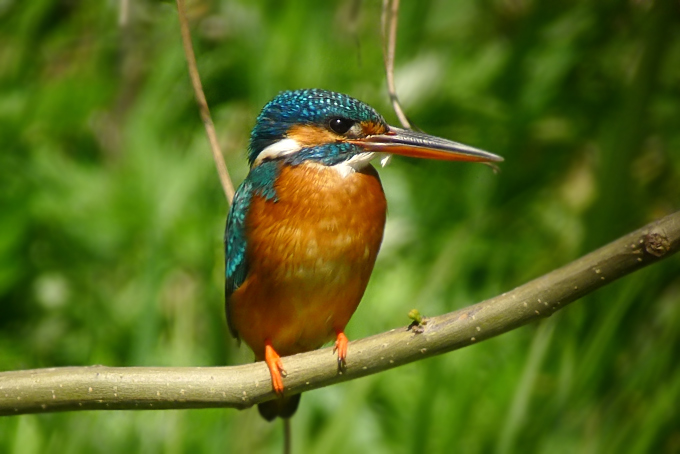
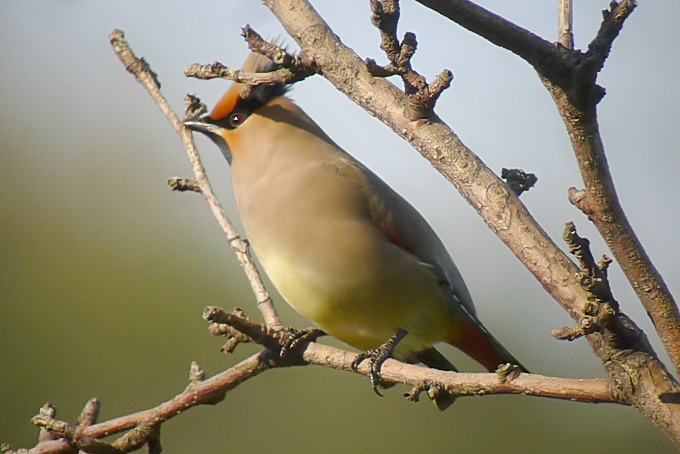
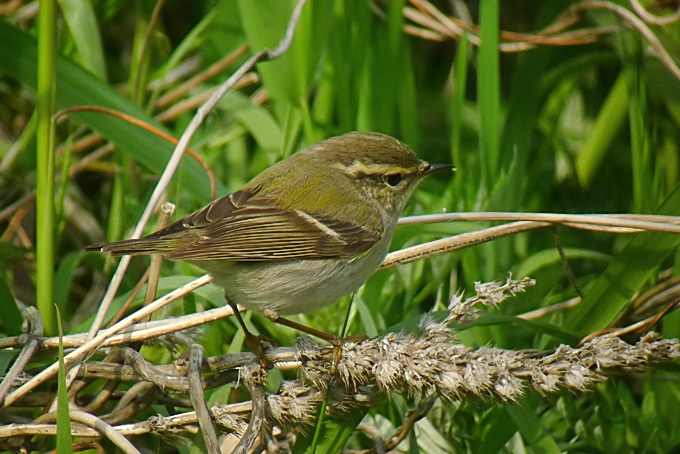
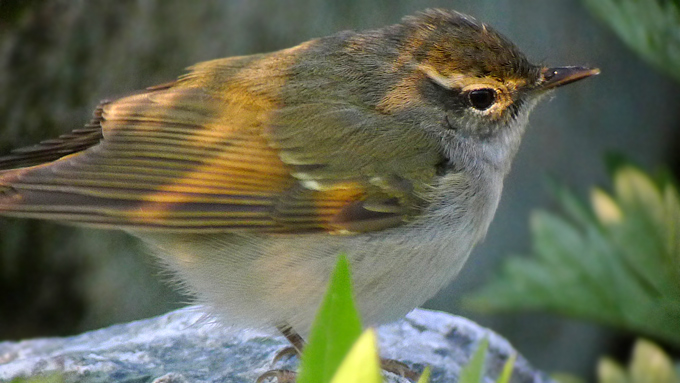
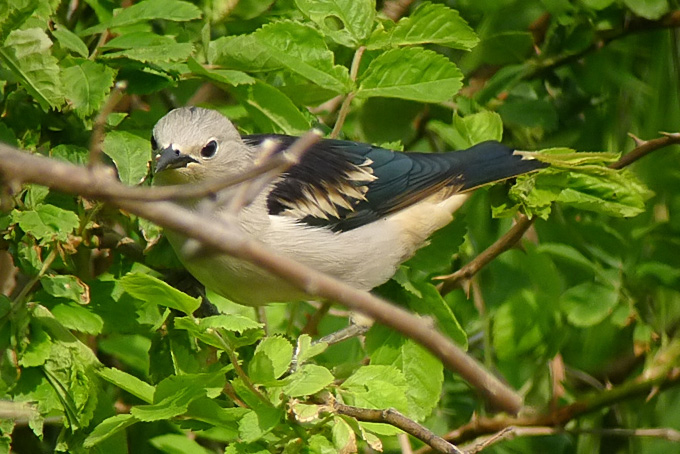
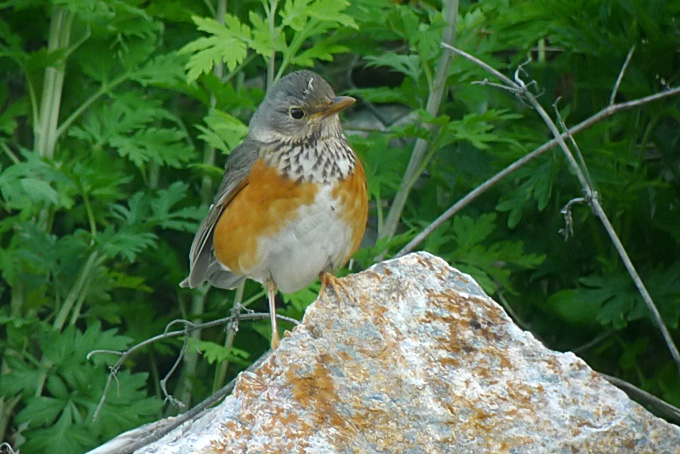
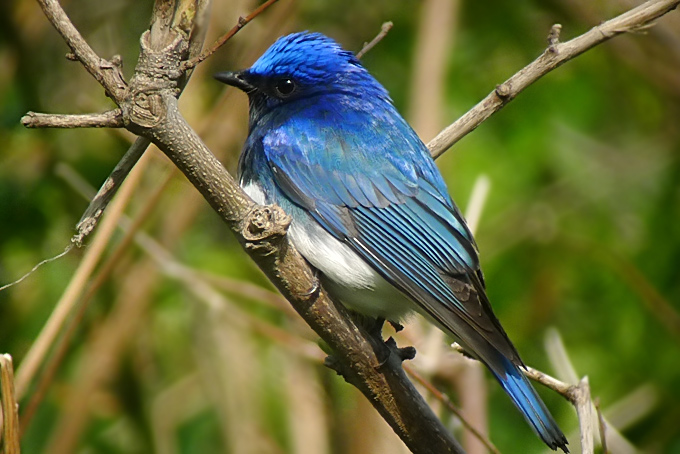
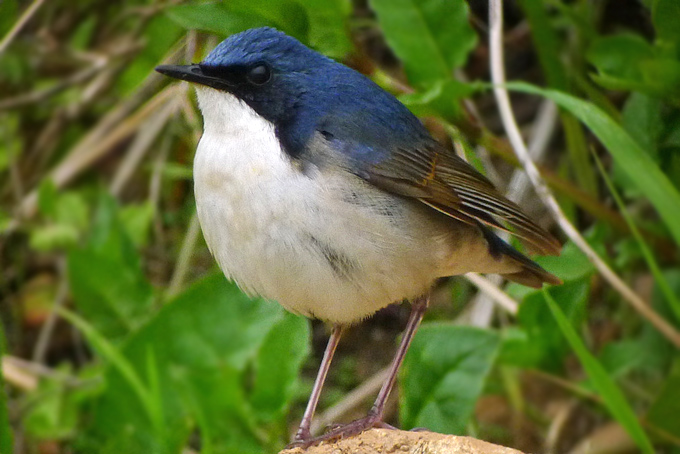
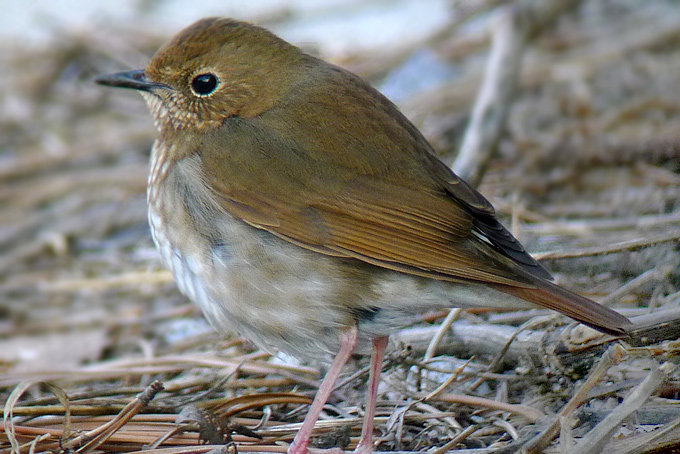
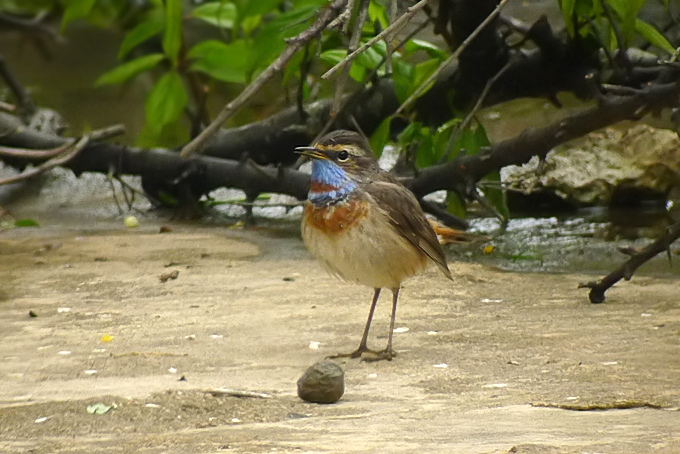
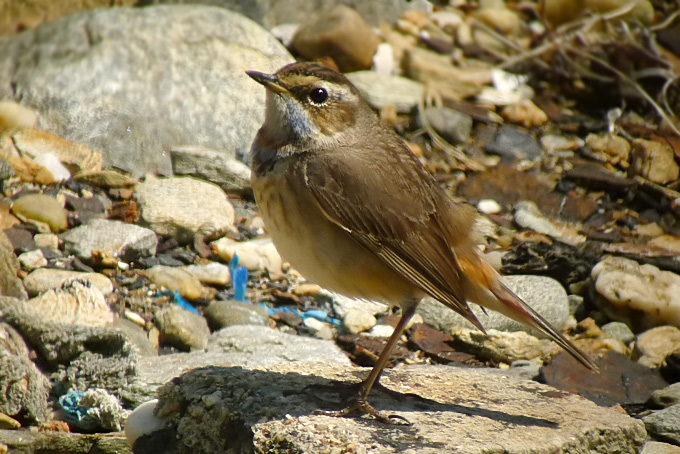
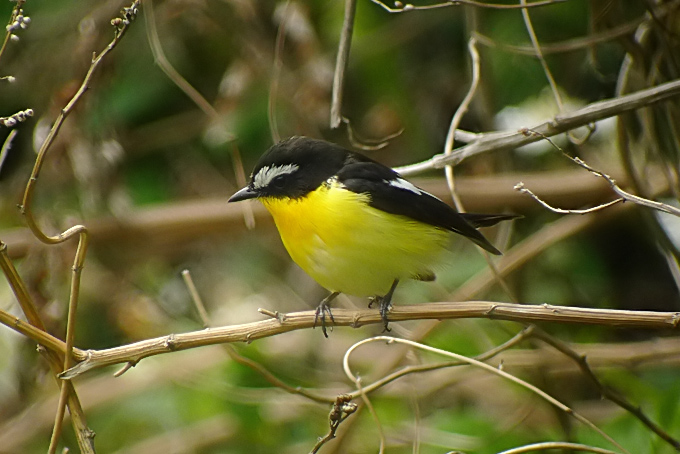
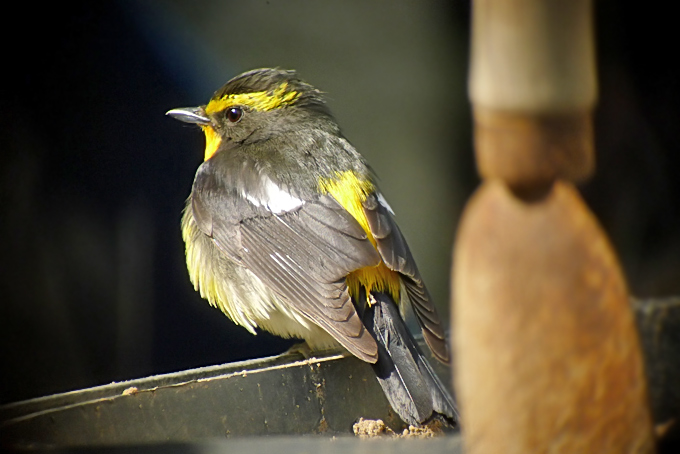
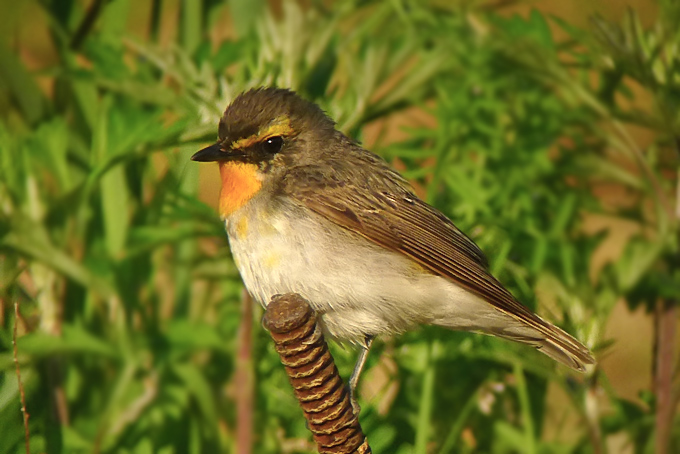

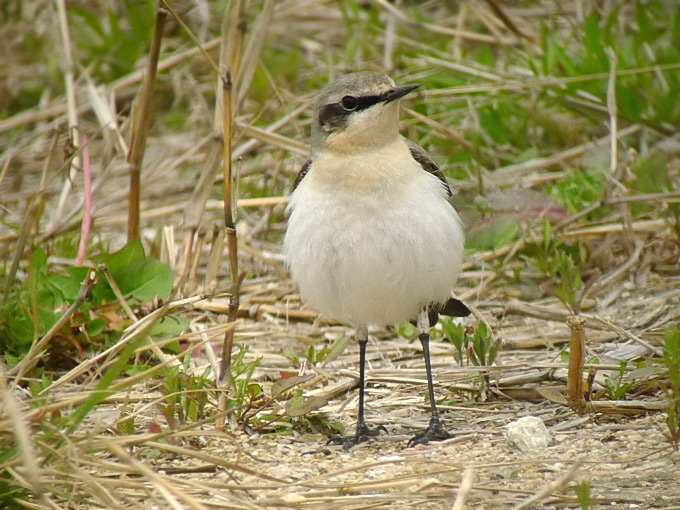
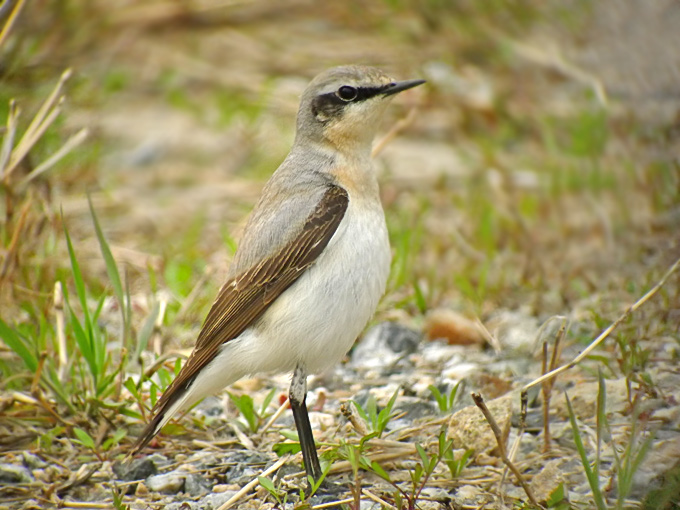
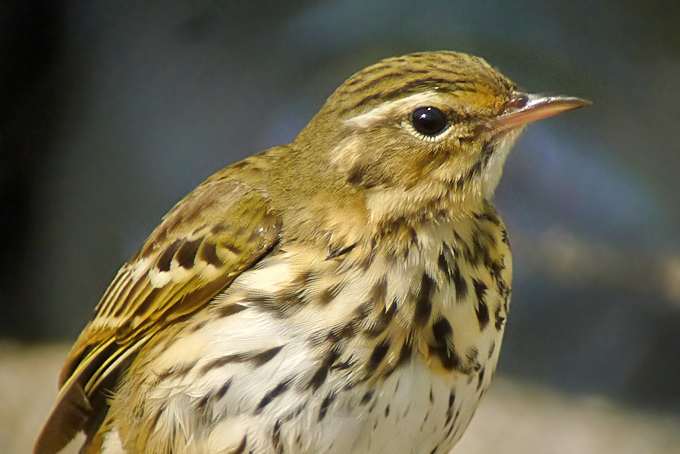
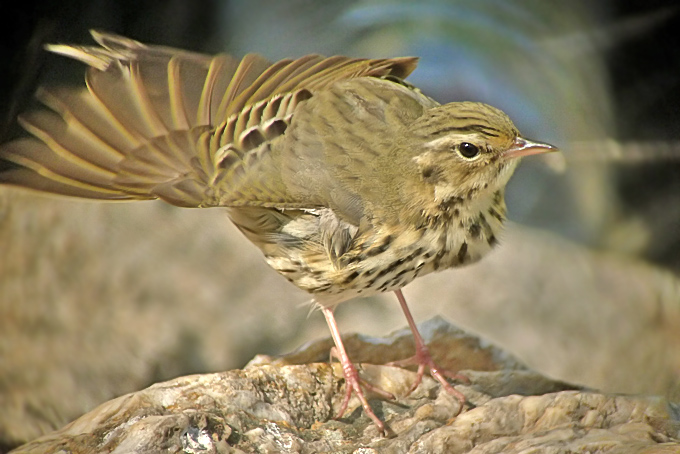
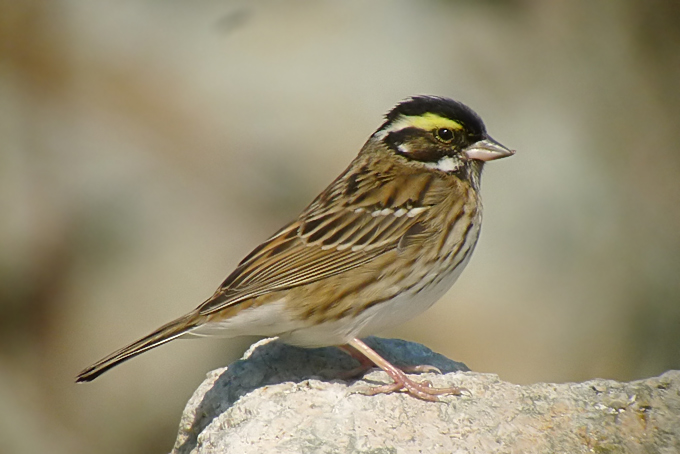
Other species observed after or before my Birdathon period include Streaked Shearwater (2) on the ferry ride to the island in, Japanese and Chestnut-flanked Whiteeye (20+), Pallas’s Reed Bunting (3+), Chestnut-eared Bunting (2+), and Chestnut Bunting (3+). There were also Siberian Thrush and Red-throated Pipit reported on the island. On the last day at Eocheongdo, we had a small arrival of Black-naped Orioles, several Dusky Warbler, grosbeak including Japanese Grosbeak, a Sharp-tailed Sandpiper seen by Mr. Patrick Blake and Mr Chae Seung Hoon, that I missed most likely because of a perched Peregrine Falcon, and a Yellow Bunting observed in the morning by Mr. Kim Ohjin.
All together we observed over 100 species in four days. It was easily one of the best trips I’ve ever had at the island. Thanks to everyone who joined, it was amazing. I’m very much looking forward to next year's Birdathon!
Happy birding!
Eocheong Island, May 4
During the recent long weekend, “Team Blake” set out on a Birdathon at Eocheong Island. The 24-hour event ran from 10:20am May 3 to 10:20am May 4, with 78 species observed during that time.
Below is Team Blake’s Birdathon tally.
- Cinnamon Bittern Ixobrychus cinnamomeus
- Striated Heron Butorides striata
- Chinese Pond Heron Ardeola bacchus
- Eastern Cattle Egret Bubulcus coromandus
- Grey Heron Ardea cinerea
- Eastern Great Egret Ardea alba modesta
- Intermediate Egret Egretta intermedia
- Little Egret Egretta garzetta
- Great Cormorant Phalacrocorax carbo
- Japanese Sparrowhawk Accipiter gularis
- Eurasian Sparrowhawk Accipiter nisus
- Peregrine Falcon Falco peregrines
- Black-winged Stilt Himantopus himantopus
- Pin-tailed Snipe Gallinago stenura
- Common Snipe Gallinago gallinago
- Common Greenshank Tringa nebularia
- Green Sandpiper Tringa ochropus
- Wood Sandpiper Tringa glareola
- Grey-tailed Tattler Tringa brevipes
- Terek Sandpiper Xenus cinereus
- Common Sandpiper Actitis hypoleucos
- Dunlin Calidris alpine
- Black-tailed Gull Larus crassirostris
- Oriental Turtle Dove Streptopelia orientalis
- Indian Cuckoo Cuculus micropterus
- Oriental Cuckoo Cuculus optatus
- Oriental Scops Owl Otus sunia
- White-throated Needletail Hirundapus caudacutus
- Pacific Swift Apus pacificus
- Common Kingfisher Alcedo atthis
- Bull-headed Shrike Lanius bucephalus
- Brown Shrike Lanius cristatus lucionensis
- Japanese Waxwing Bombycilla japonica
- Eastern Great Tit Parus minor
- Brown-eared Bulbul Hypsipetes amaurotis
- Barn Swallow Hirundo rustica
- Red-rumped Swallow Cecropis daurica
- Japanese Bush Warbler Horornis diphone
- Korean Bush Warbler Horornis canturians
- Asian Stubtail Urosphena squameiceps
- Dusky Warbler Phylloscopus fuscatus
- Yellow-browed Warbler Phylloscopus inornata
- Kamchatka Leaf Warbler Phylloscopus examinandus
- Pale-legged Leaf Warbler Phylloscopus tenellipes
- Eastern Crowned Warbler Phylloscopus coronatus
- White-cheeked Starling Spodiopsar cineraceus
- White’s Thrush Zoothera aurea
- Grey-backed Thrush Turdus hortulorum
- Eyebrowed Thrush Turdus obscures
- Pale Thrush Turdus pallidus
- Brown-headed Thrush Turdus chrysolaus
- Dusky Thrush Turdus eunomus
- Bluethroat Luscinia svecica
- Rufous-tailed Robin Luscinia sibilans
- Red-flanked Bluetail Tarsiger cyanurus
- Daurian Redstart Phoenicurus auroreus
- Stejneger’s Stonechat Saxicola stejnegeri
- Blue Rock Thrush Monticola solitarius
- Grey-streaked Flycatcher Muscicapa griseisticta
- Asian Brown Flycatcher Muscicapa latirostris
- Narcissus Flycatcher Ficedula narcissina
- Mugimaki Flycatcher Ficedula mugimaki
- Taiga Flycatcher Ficedula albicilla
- Blue-and-white Flycatcher Cyanoptila cyanomelana
- Eastern Yellow Wagtail Motacilla tschutschensis
- Grey Wagtail Motacilla cinerea
- White Wagtail Motacilla alba
- Olive-backed Pipit Anthus hodgsoni
- Buff-bellied Pipit Anthus rubescens
- Brambling Fringilla montifringilla
- Chinese Grosbeak Eophona migratoria
- Eurasian Siskin Spinus spinus
- Tristram’s Bunting Emberiza tristrami
- Chestnut-eared Bunting Emberiza fucata
- Little Bunting Emberiza pusilla
- Yellow-browed Bunting Emberiza chrysophrys
- Yellow-breasted Bunting Emberiza aureola
- Black-faced Bunting Emberiza spodocephala
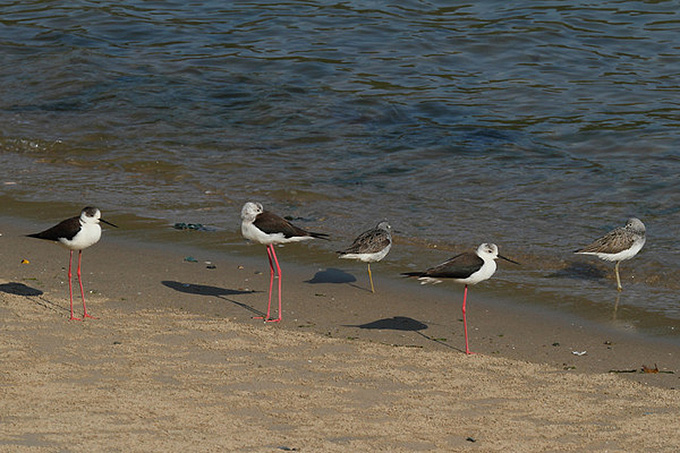
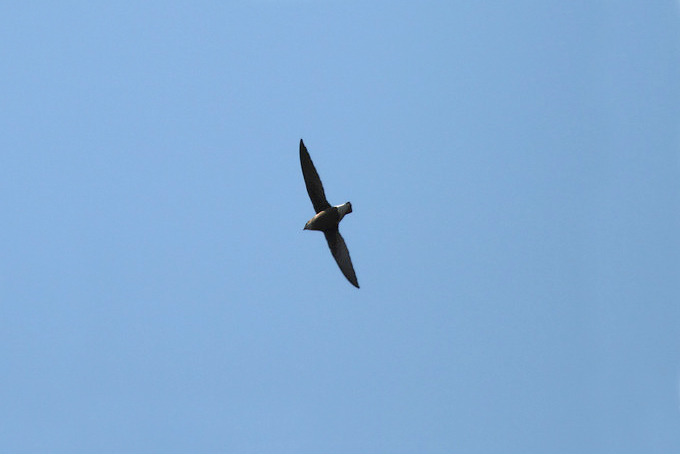
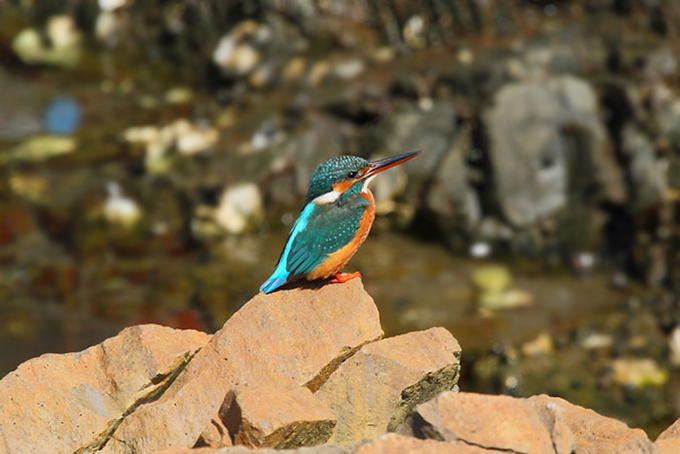
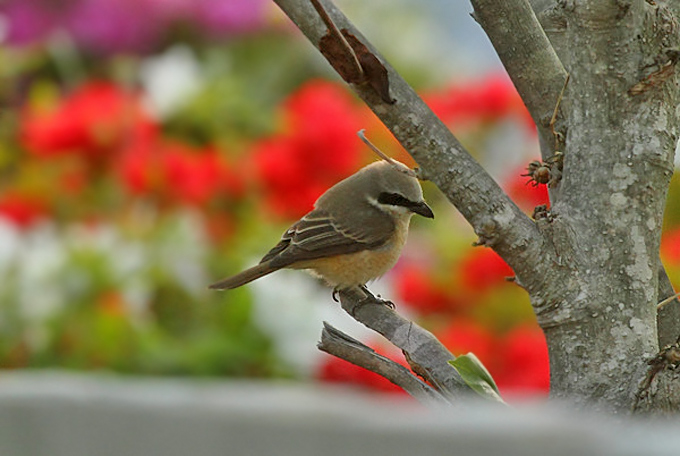
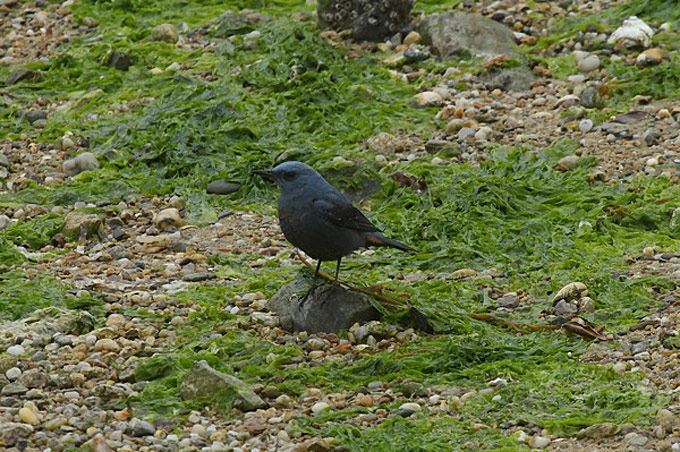
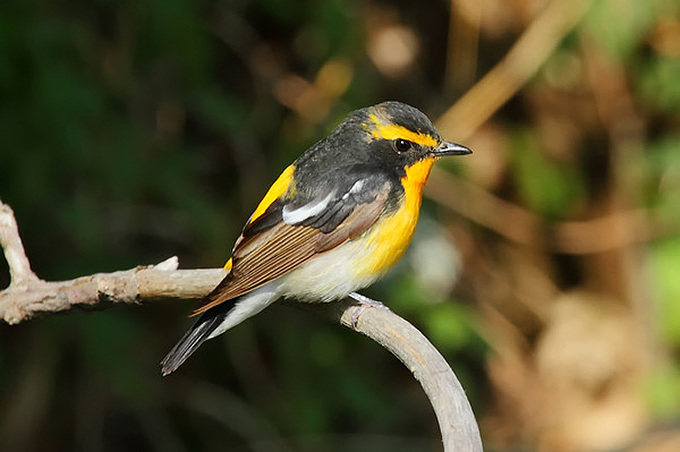
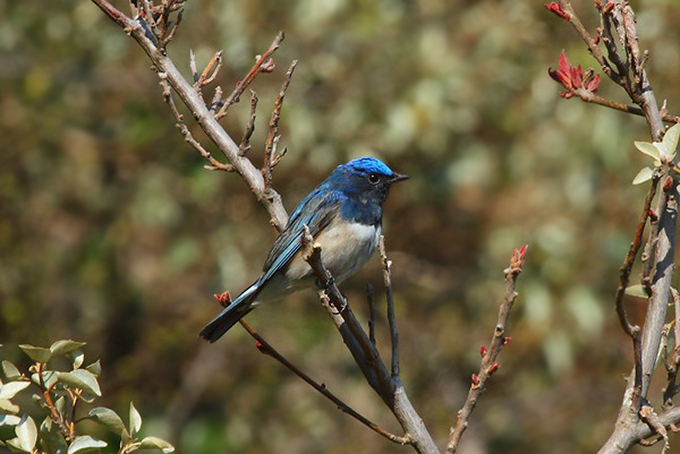
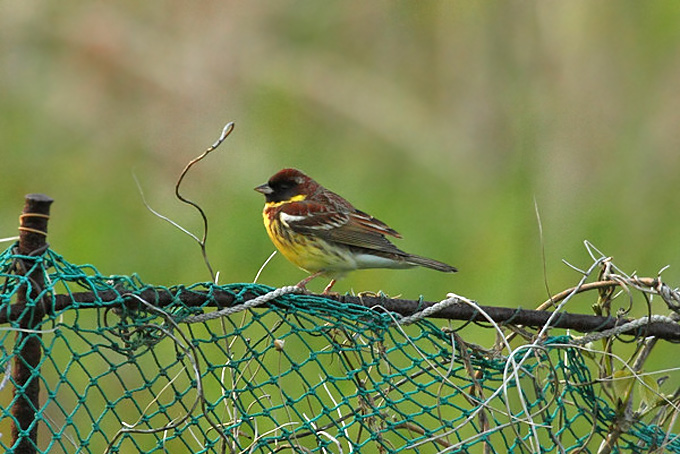
Other highlights observed on Eocheong-do after the Birdathon count period were a magnificent Northern Wheatear, two male Chestnut Buntings, Japanese Wagtail, Ashy Minivet, Japanese White-eye and Chestnut-flanked White-eye, Radde’s Warbler, Black-naped Oriole, and Chestnut-cheeked and Red-billed Starling. We did not have luck with pelagic species on the return ferry, but on our trip out to Eocheong-do we did manage to see two Streaked Shearwaters.
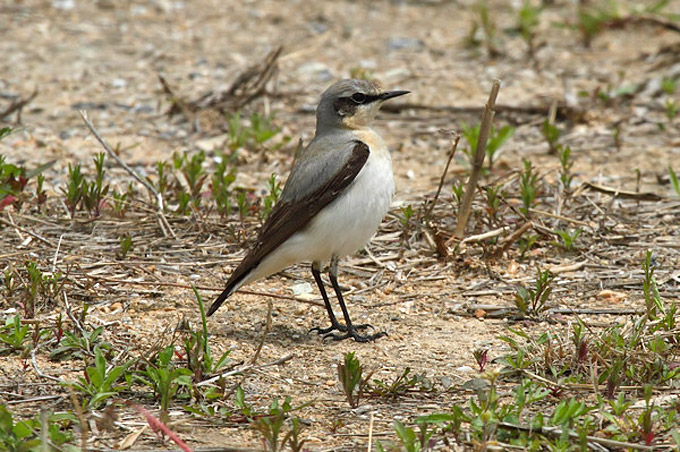
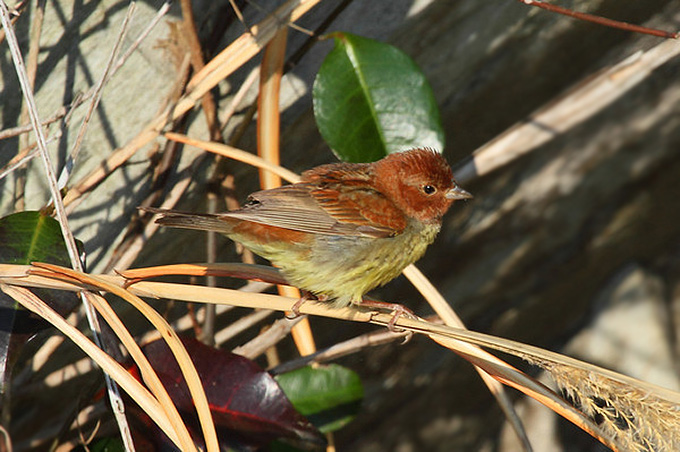
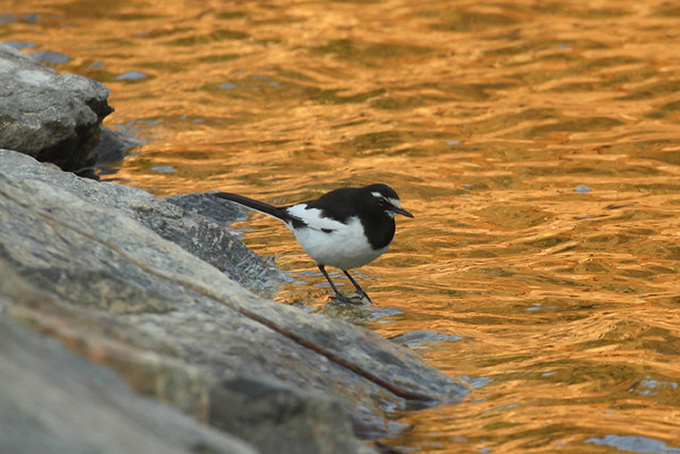
Yongjeong Island, May 3
A nice spring feel to the Island now with e.g. plentiful singing Yellow-browed Warbler, two Blue-and-white Flycatcher, a Barn Swallow, Little Tern, Striated Heron and other migrants.
On the salt pans there were Grey-tailed Tattler, Little Ringed Plover, Common Greenshank and Wood Sandpiper, while on the southern mudflat still a large number of Dunlin, 8 Black-faced Spoonbill, Saunders's Gull, a pair of Eastern Oystercatcher, Kentish Plover, 100+ Bar-tailed Godwit, Grey Plover, Far Eastern Curlew, and c. 200 Whimbrel.
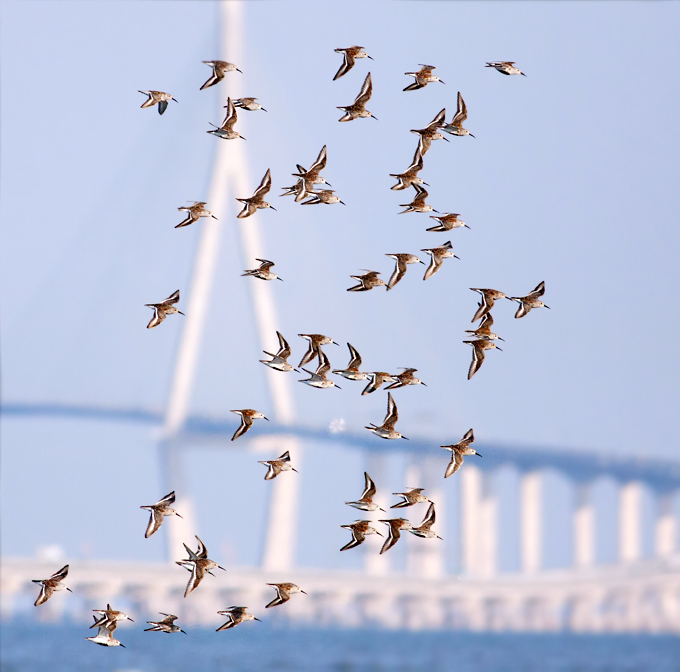
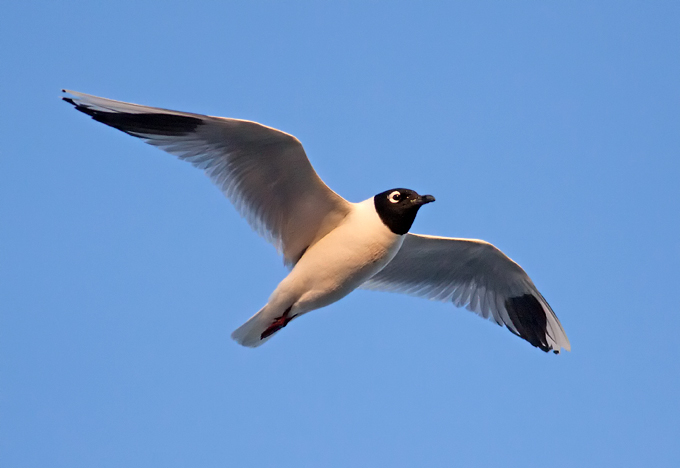
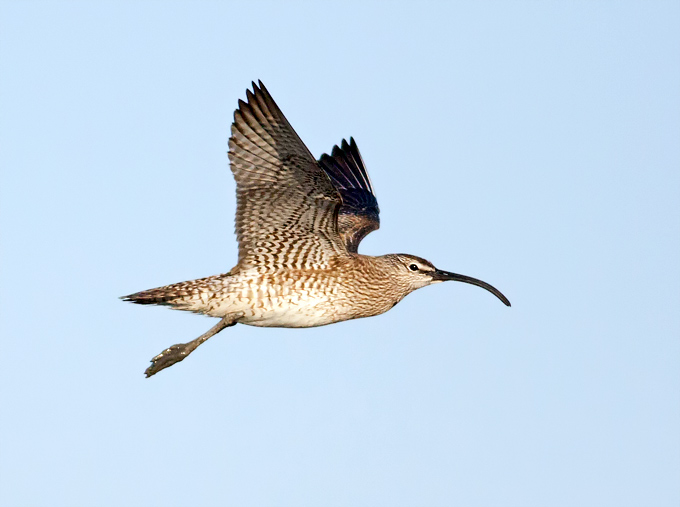
Gageo Island, May 1 - 3
Even though I have birded for a couple of years in Korea, this was my first birdathon. To that end, I had planned carefully to stay ahead of the holiday crowds and emergency at work. What I did not account for was the inexplicable cancellation of the boat (even though the weather conditions were perfect!) to my planned destination. So within a matter of 15 minutes and a couple of phone calls, my ‘birdathon arena’ changed from Korea’s westernmost island to south-westernmost.
The sea crossing from Mokpo produced a loon sp. flying low over water, distant views of some tern sp. and a Kestrel flying over the boat. My birdathon started once I dropped off my bag at the minbak and headed out (with bated breath) at 1:08pm. Over the course of next 24hrs, I spent about 14hrs in the field (covering the main village and 2-gu) and spotted 75 confirmed species. The list is as follows:
- Little Bunting, most numerous bird during the period of stay
- Red-throated Pipit, the 3rd most numerous bird species
- Black-faced Bunting
- White Wagtail
- Grey Wagtail
- Buff-bellied Pipit
- Wood Sandpiper
- Common Sandpiper
- Straited Heron
- Black-tailed Gull
- Mongolian Gull
- Temminck’s Cormorant
- Pelagic Cormorant
- Great Egret
- Cattle Egret
- Grey Heron
- Brown-eared Bulbul
- Black-winged Stilt
- Sanderling
- Temminck’s Stint
- Tong-toed Stint
- Terek Sandpiper
- Barn Swallow
- Red-rumped Swallow
- Eurasian Sparrowhawk
- Korean Bush Warbler
- Yellow-browed Warbler
- Asian Brown Flycatcher
- Blue and White Flycatcher
- Eastern Yellow Wagtail
- Olive-backed Pipit, 2nd most numerous species (including one eating a skink!)
- Asian Stubtail
- Narcissus Flycatcher
- Yellow-rumped Flycatcher
- Long-tailed Tit, part of a wave coming off the sea at about 5pm consisting of about 2 dozen birds
- Varied Tit, very local with 1 individual seen carrying nesting material
- Eurasian Siskin
- Blyth’s Pipit, at least 3 birds seen in the quarry (including one taking a sand bath)
- Dusky Warbler
- Oriental Turtle Dove
- Eurasian Tree Sparrow
- Daurian Redstart
- Japanese Whiteeye
- Stejneger’s Stonechat
- Japanese Waxwing, a group of 27 birds perched on the same tree
- Light-vented Bulbul
- Siberian Blue Robin
- Ashy Minivet
- Brambling
- Bull-headed Shrike
- Japanese Bush Warbler
- Taiga Flycatcher, close views of a cracking male
- Citrine Wagtail, seen both in 1 and 2-gu
- Chinese Grosbeak
- Common Snipe
- Blue Rock Thrush
- Dusky Thrush
- Pale Thrush
- Black Woodpigeon, about 10 birds in all (2 in 1-gu, 1 on the road to 2-gu and 7 on the trail from 2-gu to 3-gu)
- Little Egret
- Tristram’s Bunting
- Yellow-browed Bunting
- Great Tit
- Eastern-crowned Warbler
- Black-naped Oriole
- Grey-streaked Flycatcher
- Pacific Swift
- Northern Hobby
- Goldcrest
- Radde’s Warbler
- Sharp-tailed Sandpiper, good views for close to 10mins as it fed a few feet from me
- Pale-legged Leaf Warbler
- Peregrine
- Siberian Rubythroat
- Grey-backed Thrush (spotted on the back trail from 2-gu to 3-gu at 1:03pm on 2nd of May)
The first few hours on the island was quite birdy, as was the following morning but since late morning of May 2nd, bird diversity and numbers were very poor indeed. There was conspicuous absence of certain families of birds like Starlings and others like thrushes were present in very low numbers. Other birds of note include close and prolonged views of a Japanese Grosbeak, a few singing White’s Thrush early morning on 3rd May, a Yellow Bunting near the main village, singing Rufous-tailed Robin, a couple of Chinese Pond-heron. On the morning of the last day, on my way to the 2-gu at the crack of dawn, I recorded a bird song that sounded interesting. Even after scouting Xeno-Canto, I was unable to find a species that sounds something like this .
Any comment on ID would be very helpful. The return journey (with a boat-load of tourist led by a loudspeaker bearing guide enjoying a ‘remote’ island tour, a detour to Hong-do as the ferry bounced over the waves … along with the customary shrieks had a feeling of an amusement park ride) had no birds worth mentioning.
Jeju, April 26 - May 2
It’s been a dynamic week on Jeju, with 85 species of birds observed. The mostly quiet week was punctuated by several busy and very birdy days midweek, right after heavy rain and SSW winds.
On April 26th, I visited Mara-do and Jeju’s west coast. Mara-do was extremely quiet, with most notable being several Richard’s Pipit, Grey and Brown-headed Thrush, and Narcissus Flycatchers. At least a dozen Streaked Shearwaters were seen from the ferry (which seemed relatively empty for a weekend).
Farmer’s fields on nearby Jeju were buzzing with singing Far Eastern Skylark, Zitting Cisticola, Stejneger’s Stonechat, and several noisy but frustratingly invisible Japanese Quail.
At a quiet Yongsu Reservoir, a pair of Garganey and a Chinese Pond Heron were notable. Pairs of White-cheeked Starlings were seen building nests in the supports for large highway signs at several west coast locations. A single Chestnut-cheeked Starling was following one pair around. Further down the road, the encouraging sight of a Red-billed Starling seen with nesting materials.
On April 29th, I was surprised when I opened to the door to my 5th floor apartment and heard a familiar call coming from the stairwell above. When I got upstairs, I saw a shaken Asian Stubtail that was trying to free itself from the building by bashing repeatedly into the closed window. I opened the window wide and left it alone, and happily it was gone 20 minutes later. One year ago on Gageo I had to rescue an Asian Stubtail from a small abandoned chicken coop, and several other birders have relayed their similar ‘Stubtail in distress’ stories to me. Why do Asian Stubtails seem to get themselves into these sorts of predicaments?
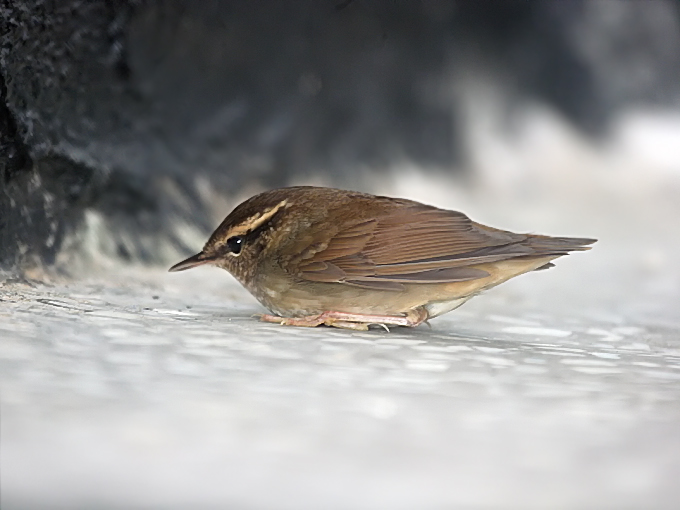
I visited Jeju’s south coast around Jungmun on April 30th, looking for some evidence of migration after the rain. I tried out a new spot on a hunch and found a small oasis filled with flycatchers and warblers. On the quiet stream I found a pair of Blue-and-white Flycatchers, a shy male Yellow-rumped Flycatcher, several Asian Brown Flycatchers, and Yellow-browed Warblers. A few active Black-faced Buntings were also seen, with two females feeding in the open, as a male sang from a nearby treetop. Also seen were two Striated Herons in crisp breeding plumage, and a presumed Swinhoe's Snipe.
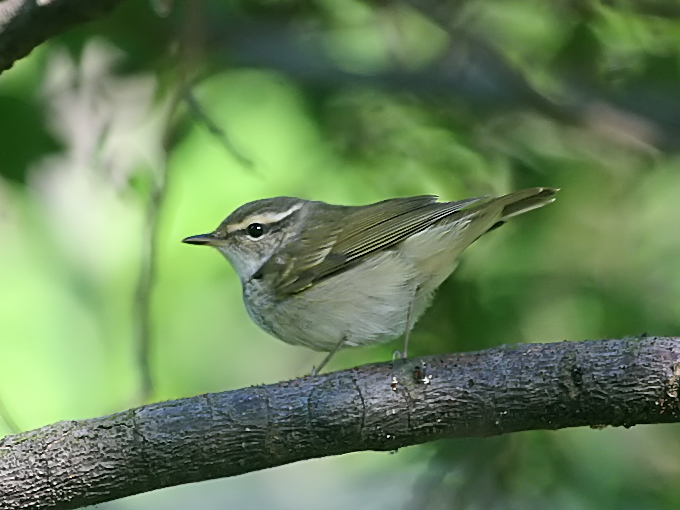
Encouraged by the rise in bird activity, I returned to these new spots on May 1st and one of the first birds I encountered was a Common Rosefinch. In a tree teeming nervously with flycatchers, white-eyes, and warblers, I saw a drab bird notable for its lack of movement. It was clearly a finch, with a strongly notched tail, (very) heavy bill, and streaked underparts. The overall drabness, heavy bill, light 'string-of-pearl' markings on the wings, and even the faint eye-ring were noted in the field, before it headed north, one tree at a time. I also heard my first Oriental Reed Warbler nearby.
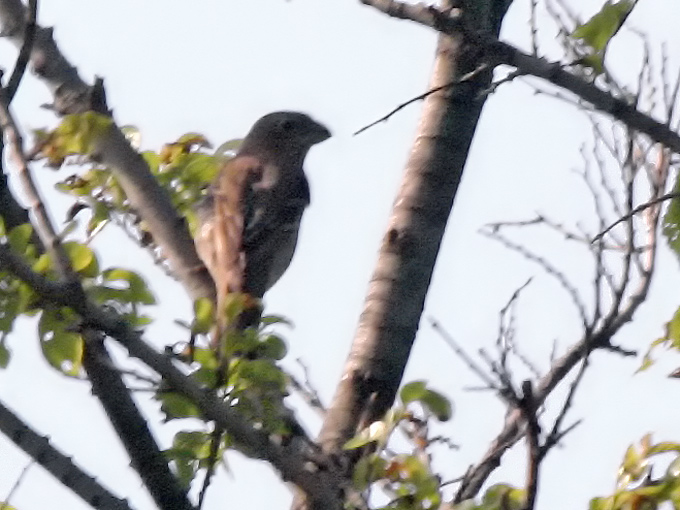
Nearby, I watched a juvenile leucopsis White Wagtail being fed and watched over by an attentive pair of adults (do they breed earlier on Jeju than elsewhere?). On the 30th, the juvenile didn't fly, instead choosing to amble around and stretch its wings. Today it made several short, ungraceful flight-hops. A Eurasian Magpie that watched the young bird too closely was sent off by one of the adult birds, in a dramatic attack.
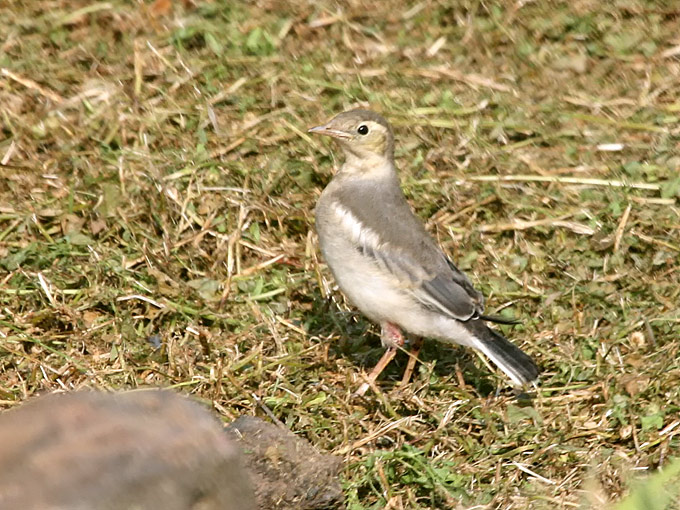
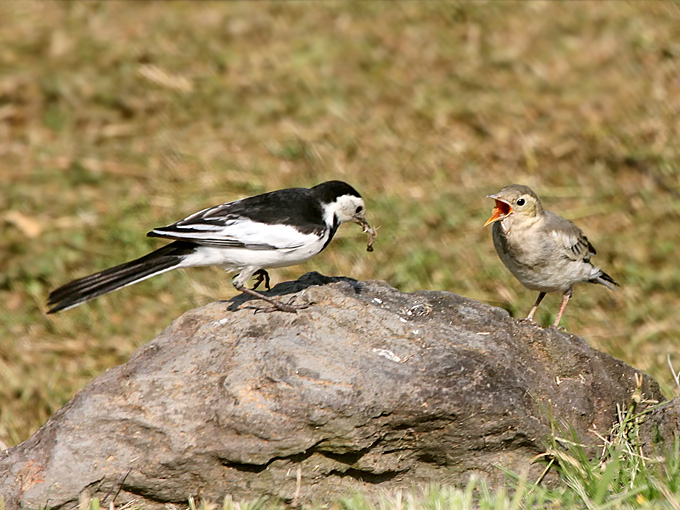
In a nearby park, I quickly picked out at least six Yellow-browed Buntings and two Little Buntings mixed in with about a dozen Black-faced Buntings. A dozen Cattle Egrets paced nervously in the ponds. This park was very 'unbirdy' for the first several years of its existence, probably due to the intensive and gaudy maintenance - bushes and weeds were whacked down as soon as they grew past the ankles, and the grass was kept golf-course short. This year, however, for whatever reasons, the vegetation in the park has been allowed to grow more naturally and unchecked, and probably as a direct result, the feeling this year is drastically different. This park now feels like a functioning system filled with predators, prey, viable and varied habitat, and an impressive range of flora and fauna - as opposed to a sterile and unchallenging place to have a picnic. Inevitably though, the site is surrounded on two sides by new and massive construction sites. The development on Jeju over the past few years has been both staggering and thoughtless.
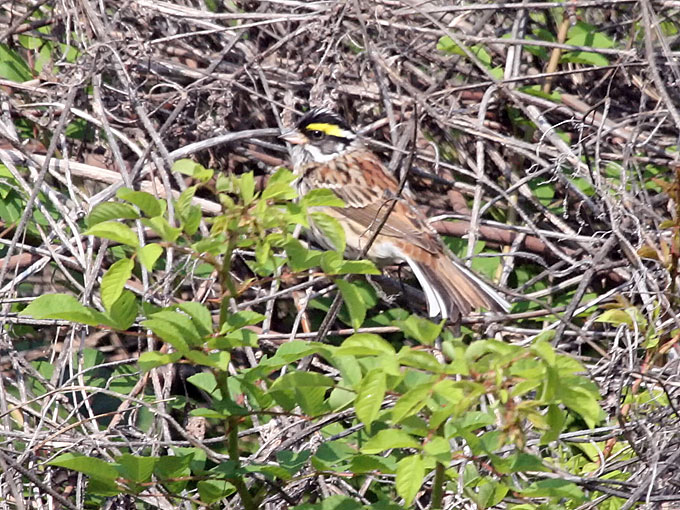
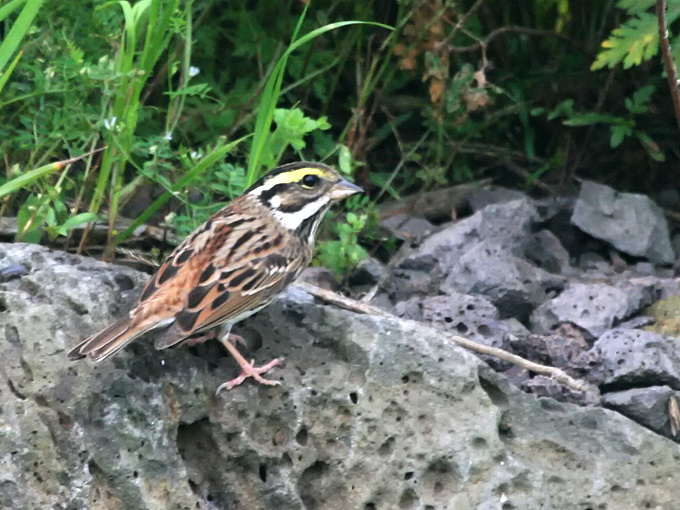
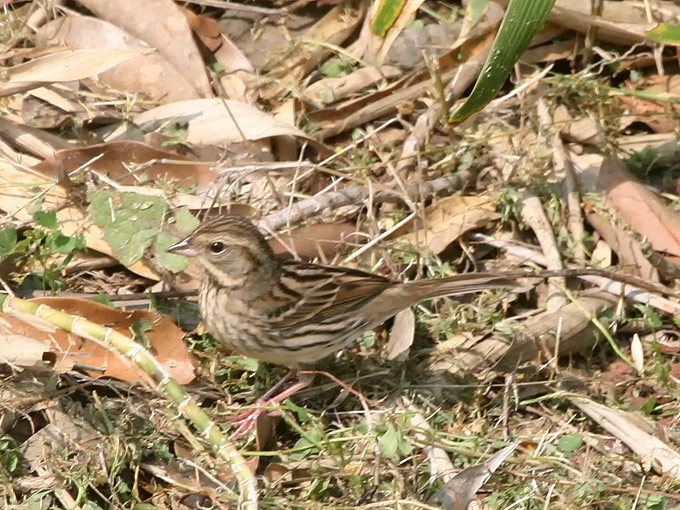
On May 2nd, the two spots that were buzzing with birds were ghostly quiet. At dawn on a tourist-ridden islet in Seogwipo’s harbour, best were an Asian Stubtail, Narcissus Flycatcher, and two Tristram’s Buntings. In a field near Jungmun, I spotted two Chestnut-eared Buntings.
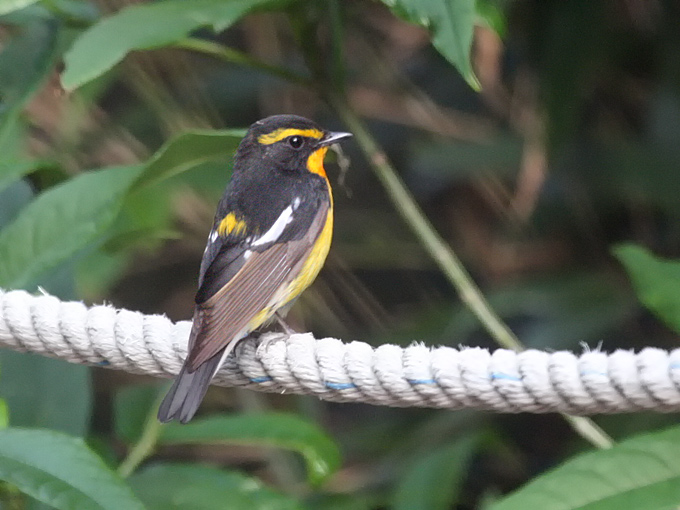
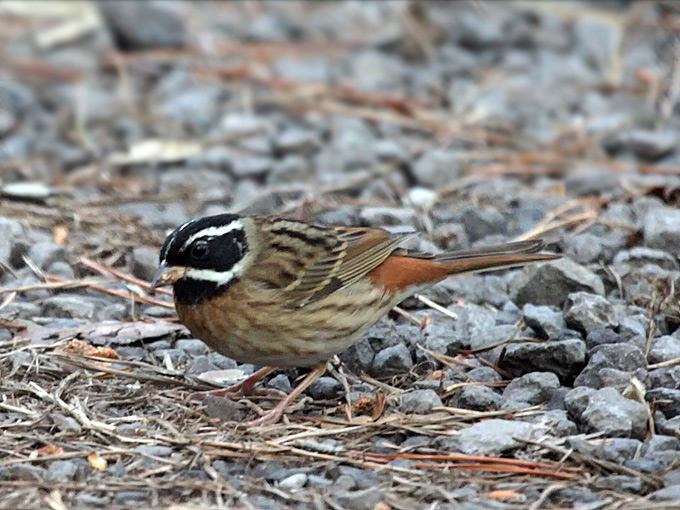
Baekryeong Island, April 30 (0935) - May 1 (0934!)
Thanks to the kind support of several donors (Park Young-Ja, Chon Hyun-ae, Profs. David Cole and Betty Slade) and the promise of some Canadian support through Birds Korean Geoff Styles, I chose Baekryeong as the obvious location for this year's solo-effort foot-it birdathon challenge. This is an island with a great diversity of habitats (forest, farmland, freshwater wetland, tidal-flat and beach, and rich inshore waters), sitting within a major migration corridor.
Starting at 0935 on April 30th (when there was a sudden surge in visible migration, including a personal first Common House Martin of the spring and several White-throated Needletails) and continuing on to 0934 on May 1st, I spent 18 hours in the field and walked about 29km - from the north-east of the island to the far southwest. In total, I heard or saw at least 142 species, almost all of them complete migrants. As I missed a few species that were on the island before starting, found several new spring arrivals within an hour of finishing (including Brown Shrike and Yellow Bunting), and left off a couple of probables (distant calling Asian Brown Flycatcher, Swinhoe's Snipe and one unknown caller - perhaps an owl) it seems that 150 plus really is possible here in a day...as long as adequate habitat remains.
Notable moments during the birdathon included flagging down a minibus carrying several local officials inspecting the proposed new road through the wetland (investing 15 worthwhile minutes trying to inform them of the high value of the site- exactly as two Purple Heron overflew us!); being followed for 15 minutes by a singing White's Thrush at 4AM, close enough to hear the whoosh of its wings in the dark; hearing Little Whimbrel, Grey-tailed Tattler, displaying Little Ringed Plovers and frantic Far Eastern Oystercatchers all before dawn-proper; and enjoying a large arrival of migrants in the far southwest, including the first and most timely Black-naped Oriole of the spring / summer at 0932 (species number 142).
A complete list with a few images will be posted later. For now, would just like to repeat my thanks to those who supported the Birds Korea birdathon this year - here and overseas - helping to cover publication costs for our report for the CBD COP. And of course, for those with their Birdathon still to do: Good Luck and Great Birding!
Aphae Island, April 29
The visit to the southern tidal-flat was mostly in cloudy conditions with occasional rain showers. On arrival the high tide was still three hours ahead and this gave the option to have a closer look onto a small group of shorebirds, mainly Bar-tailed Godwit, a few Whimbrel and Mongolian Plover, one Red Knot and one Chinese Egret.
In the adjecent fields several Common Greenshank and c. 20 Little and Eastern Great Egret as well as a few Grey Heron were seen.
With running-in tide the number of birds increased immense: 400 Bar-tailed Godwit, 70 Grey Plover, 1 Pacific Golden Plover, 50 Whimbrel, 160 Ruddy Turnstone, 60 Great Knot, 30 Grey-tailed Tattler, 40 Terek Sandpiper (one with a yellow leg flag), 2 Curlew Sandpiper, 80 Mongolian Plover, 1500 Dunlin, c. 50 Red-necked Stint, small number of Kentish Plover and one Far-eastern Curlew.
Eventaully the tide washed all birds onto a concrete path which leads onto the tidal-flat, the tall birds at the end and the small ones at the front. In the mix of shorebirds c. 20 Little Tern tried to find a place; the wind and waves kept the birds in the back constantly shoving around so that the visit of 5 Chinese Egret was rather short. The small birds in the front seemed to had a much more relaxed time. In total eighteen leg-flagged birds were seen.
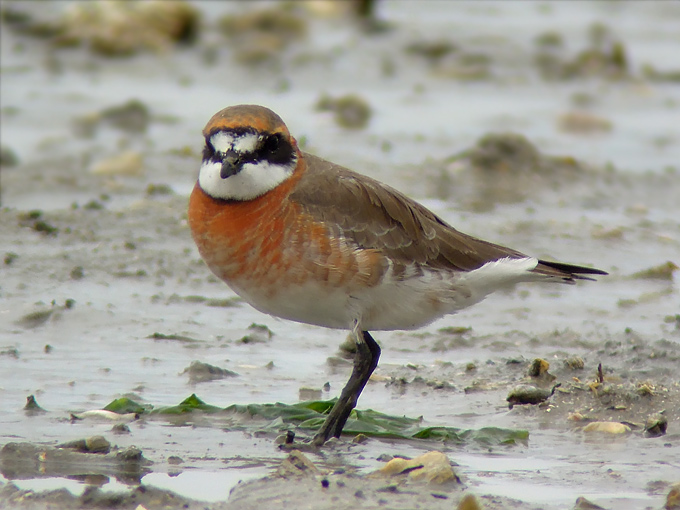
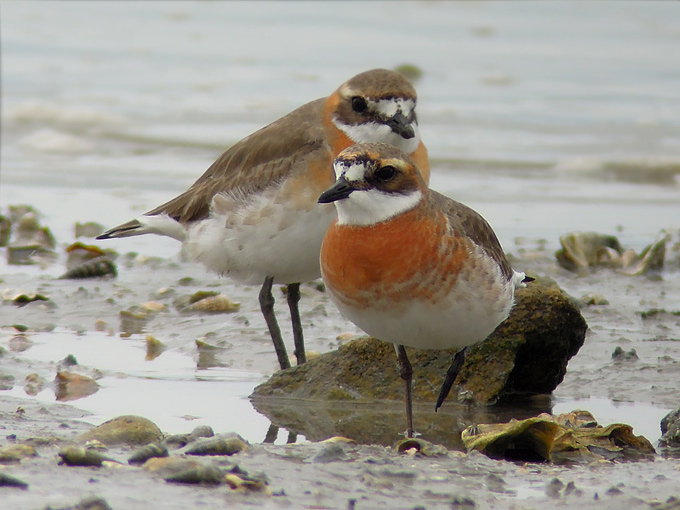
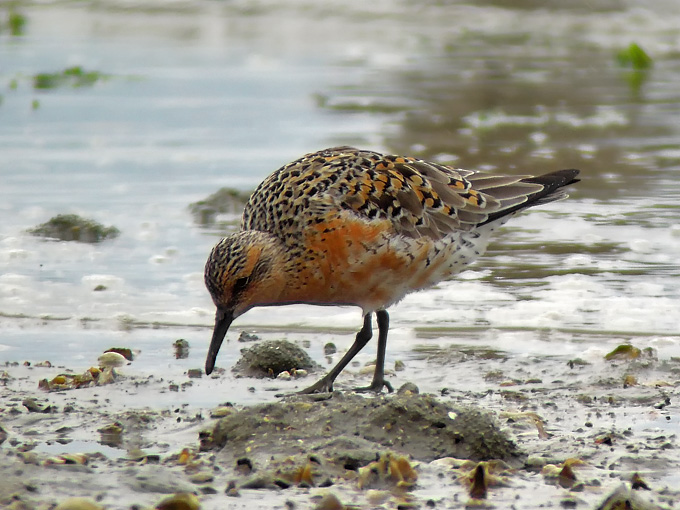
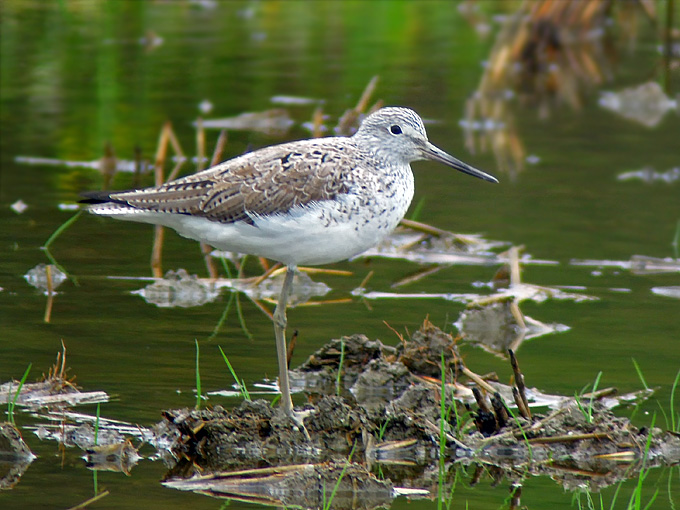
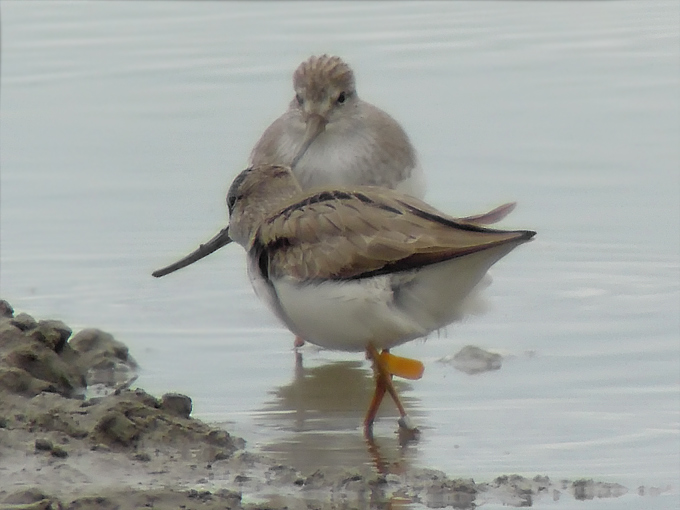
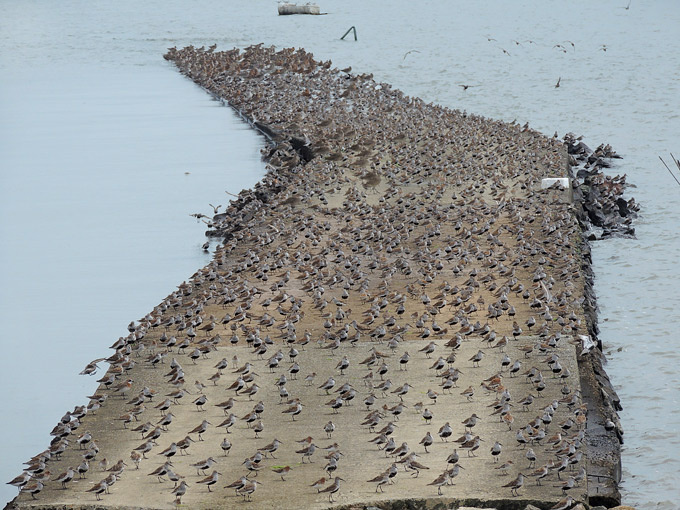
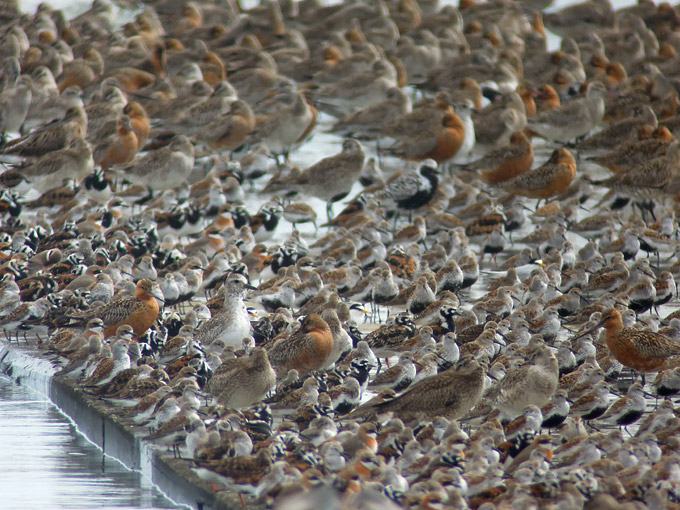
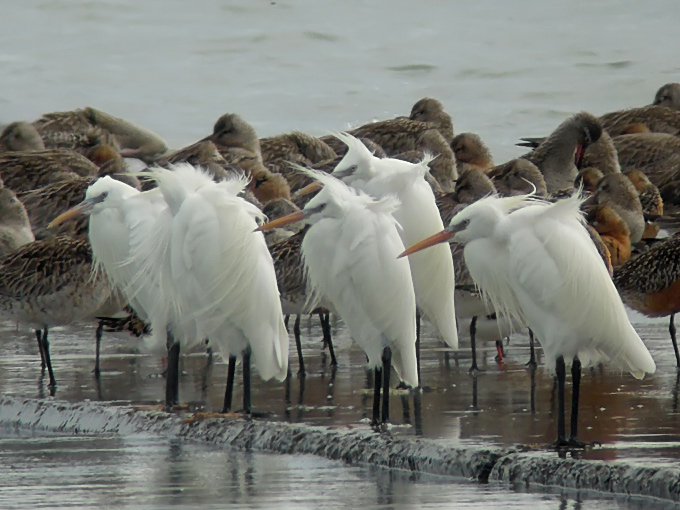
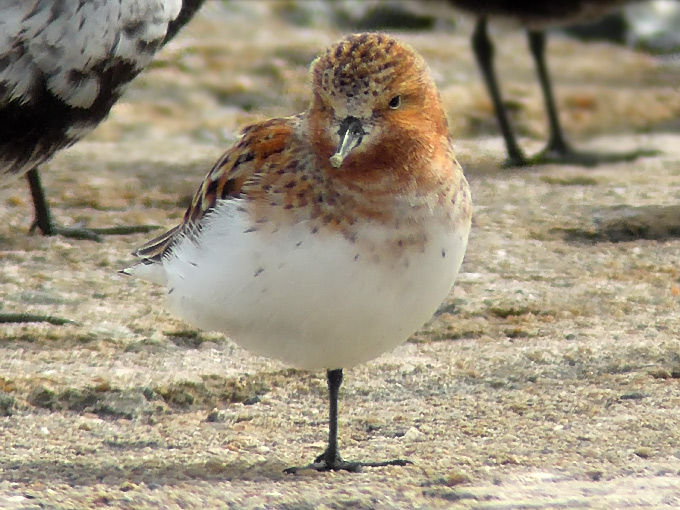
Birds Korea 1108 Ho, 3 Dong, Samick Tower Apt., 148-22, Namcheon-Dong, Su-Young-Gu
Busan, 618-762 Republic of Korea





